Much of the Ukrainian conflict has its closest comparison in the Normandy campaign of World War 2, just after the famed D-Day landings. The Normandy region is known as ‘hedgerow country’, populated with an endless sprawl of fields and pastures called bocages.
They’re constructed in such a way on purpose: the treelines are planted as windbreaks which block the wind from stripping the soil of the pastures. This is exactly how much of Ukraine’s inner territory of ‘The Wild Fields’ is situated.
This terrain presents a unique set of challenges for advancing forces. The most obvious reason is each set of treelines and hedgerows is typically garrisoned with defending troops who dig trenches and fortifications inside of them. They can see out of the treelines, using drones and other ISR methods, to spot any enemy crossing the fields, but the enemy has great difficulty seeing them in the dense vegetation.
Here’s an example from Ukraine’s Zaporozhye, near Rabotino, where they tried so desperately to advance through exactly such bocage terrain:
Now before we continue on, a brief history refresher:
Once the allies landed on the Normandy beaches on D-Day, June 6, 1944, their next task was to slowly expand the beachhead. To do this, they had to fight a series of campaigns during that period of July and August, 1944, passing from the beaches to bocage country of Normandy, France, toward the strategically important crossroads city of Caen.
Here you can see the yellow arrows representing the D-Day landing trip onto the Normandy beaches of northern France. The red arrows are how allied forces had to expand their control zone, to eventually liberate Paris and trudge onward.
Here’s a satellite view of exactly that area near Caen, which allies had to push through after their landings:
What’s most interesting and comparable about those early June advances is the fact that the forces involved were not of the great proportions we typically associate with WW2—armored divisions squaring off as in the Kursk battle. Since the initial beachhead was relatively small, the allied forces which first ventured outward to begin securing important roadways and junctures to link the beaches were battalion and regiment in size, and faced off with equally smaller battalion formations of the Wehrmacht.
This is noteworthy to compare as we have clearly seen the Ukraine conflict devolve into smaller detachments and elements facing off, with attacks consisting mostly of several companies at a time rather than entire brigades or divisions.
Here’s one of the best videos that captures those early assaults with easy-to-follow graphics:
In particular, watch the segment highlighting the 101st Airborne assault on Carentan:
You can see how there was no real quick-fix or silver-bullet strategy for dealing with the bocages. Both sides simply dug into the treelines and waylaid onto the other, waiting for one or the other to cry uncle first. At the end it’s stated the 101st suffered 50% casualties—a high price for advancing through the grinder of the bocages.
And they had far less to deal with back then. Now each side has remote mining capabilities which strews the fields with tens of thousands of mines on call; drone ISR giving complete surveillance overwatch, negating any strategic deception; and accurate artillery, including with various guided rounds and strike drones, which allows hitting the enemy at far greater distances, long before he even gets close to your treeline fortifications.
If you study the other battles of that opening Operation Overlord period, like Villers-Bocage for instance, you’ll note that detection capabilities were fairly limited. In the Battle of Villers-Bocage, German Tiger Ace Michael Wittmann single handedly destroyed an entire column of British tanks because they had unwittingly rolled by in front of him. He was shocked to see a whole column lumbering past his position and immediately exploited it. Nowadays, with the types of long range drone ISR both sides field, it’s impossible to approach even within 5-10 kilometers of your enemy without being instantly spotted.
When Ukraine’s big Zaporozhye counteroffensive began in early June of this year, even in the dead of night, Russian ISR systems spotted the mass Leopard/Bradley columns rolling out of their staging areas in Mala Tokmachka, above Rabotino.
Thus, the way the allies “solved” the bocage problem in Normandy was simply by out-maneuvering German forces to surround them due to the luxury of being able to covertly transport columns of troops without necessarily being spotted.
The other thing to remember is, once the allies established their beachhead and were able to safely ensconce more forces there, they vastly outnumbered the regional German garrisons. Operation Overlord, the general umbrella under which most of the post Normandy expansions took place, officially listed 1.5 million allied troops by late July against a mere 380k German troops.
Operation Cobra is officially listed as including a massive ~2,500 allied tanks and tank destroyers against a paltry 190 German tanks and assault guns. This is to highlight the fact that allied forces were able to create opportune encirclements of German forces, like in the Falaise Pocket, due to sheer overwhelming superiority.
But in the Ukraine war, the forces are relatively even. Thus, Russia cannot pour such overwhelming forces into envelopment maneuvers and break out of the infamous bocage stalemate positions we see on every frontline.
Let’s use this opportunity to explain why exactly the forces have always remained at relative parity. In the Ukraine conflict, each side adjusts their numbers based on what’s needed in order to plug gaps and keep relative parity to what the other side has. It’s not possible to overwhelmingly boost your numbers because any large-scale mobilizations are telegraphed months in advance and can be matched by your enemy.
To clarify: let’s say both sides have 500,000 men. One side wants to increase theirs to 800,000 and overwhelm the other. To recruit the additional 300,000 men, give them basic training, equip them, then fill them out in their various battle orders and embed them into actual units, takes months of time. Every step of this process is seen by the other side, because hiding the mobilization of hundreds of thousands of troops is impossible. And once they’re mobilized, you further can’t hide their deployment to specific frontline zones.
That means if one side were to boost their troop numbers by 300k, the other side will be inclined to likewise go into an immediate and urgent mobilization run to boost theirs by 300k to continue maintaining rough parity.
Thus, neither side necessarily feels obliged to vastly out-mobilize the other because why go through the effort to destabilize your society in such a way when you know the enemy will simply negate your numbers, and your new troops will not have any additional effect on the frontline?
If Russia suddenly went into full ‘war mode’ as so many of the turbo-patriot and concern-troll types rabidly plead for, and suddenly announced a 1 million man mobilization, Kiev would likewise announce their own full societal mobilization to match it. Sure, they might have far more problems doing so, but ultimately they’d be able to dredge up semi-able bodies at a similar time-scale as that of Russia.
So instead, Russia knows it must try to create breakthroughs via sheer tactical advantage—outwitting the opponent, rather than relying on massive force disparities in the way the allies had the luxury of as mentioned before.
But how do you break the deadlock when both sides have roughly even numbers and equipment, and you’re faced with the infamous bocage terrains filled with mined fields separated by perfectly defensible treeline and hedgerow positions?
There are two primary ways currently being employed to do this. Let’s cover both in depth.
Scorched earth method
This is a brute force method which in essence consists of artillery fire-bombing the trench positions in the hedgerows and treelines to such an extent that they don’t exist anymore, and any remaining occupants are forced to flee or are simply too few in number to successfully defend their positions. At that point a company of motorized/mechanized men is sent to capture the position then reinforce and fortify it, if possible.
You do this one hedgerow at a time, advancing one field, then another the next day, etc.
The problem with this method is that often the trenchworks, as stated above, are destroyed, which means your own troops can’t really occupy them or make them adequately defensible in time. They can work on it, but the enemy will now be striking you with its own artillery in the interim while your troops are still in inadequate cover. Once they’ve recouped and regrouped in the 2nd echelon line 2-3km back (or less), the enemy will also launch counterattacks to try to dislodge you from those positions. And given that you haven’t had time to “dig in” and adequately reinforce them yet, you will be caught out in the open and in a weaker position than the enemy himself was when you attacked him.
Combined arms multi-domain
The far more advanced type of attack is one that utilizes every conceivable asset at your disposal to weaken, confuse, and misdirect the enemy in such a way that an attack can be launched either unexpectedly or in such a way that the enemy is somehow off-balance, distracted, or dispersed to the point of not being able to concentrate his forces.
Almost every ‘great’ and legendary attack in history was organized in such a way as to utilize subterfuge, misdirection, and highly clever planning. In short: the definition of high level strategic thinking. Even the D-Day landings discussed earlier began with Operation Titanic, a “fake” landing attack much farther north which sought to drop parachuting dummies to fool the Germans into thinking the attack vector would happen there rather than the 5 famous Normandy beaches where the real attack proceeded hours later.
In war, when you don’t have an overwhelming force advantage which allows you to ‘brute force’ your way through any deadlock, you must rely on very well-crafted deception, subterfuge, and general strategic planning which aims to split and distract the enemy, allowing a small window of time for your highly trained main force to wedge themselves into some kind of advantageous position which can then be expanded like a crack in a stone block.
In the big summer Zaporozhye counteroffensive, Ukraine attempted various strategems in the form of feints to make Russia commit reserves to areas where the main attack would not actually transpire. This included deceptions like moving troops around in Kherson under the ostensible auspices of preparations for river crossings, which included the blowing of the Kakhovka dam on June 6th, right at the outset of the counteroffensive, in order to create confusion and fear. But also attacks on secondary axes like Staromayorsk, near Velyka Novosilka to make Russia think that would be the main axis.
Much blame has been heaped on Russian advancement attempts for lacking any sort of artful strategic planning of this sort that could facilitate real operational level breakthroughs, encirclements, and strategic defeats of enemy groupings. Many have espoused the opinion that Russian forces have often relied on pedantic, unimaginative, and not-well-thought-out brute force methods of just ramming directly ahead against enemy defenses. Ugledar was an oft-cited example of this. But let’s take a look and see if that’s truly the case in Avdeevka.
Avdeevka
So now we get to Avdeevka, which is shaping up to be the most significant battle of the second half of 2023 on the Russian side, after Bakhmut. What can we glean of Avdeevka apropos Russia’s strategies, or lack thereof, and which methods does Russia appear to be utilizing?
It appears what Russia has chosen is a mass multi-pronged attack, with many of the directions perhaps being decoys. The idea is to spread Ukrainian defenses, not allowing them to concentrate on one given axis. This was even larger than some realized because the axes were not all limited to Avdeevka only, but even in neighboring fronts. The two largest were assaults just south of Pervomaisk, as well as south of Marinka toward Novomikhailovka:
There were fairly large assaults with videos showing columns of armor. The fact that both Novomikhailovka and Pervomaisk are in danger of falling into a boiler similar to Avdeevka, means those are particularly sensitive fronts for Russian advances where Ukraine cannot at any cost allow even a meter to fall.
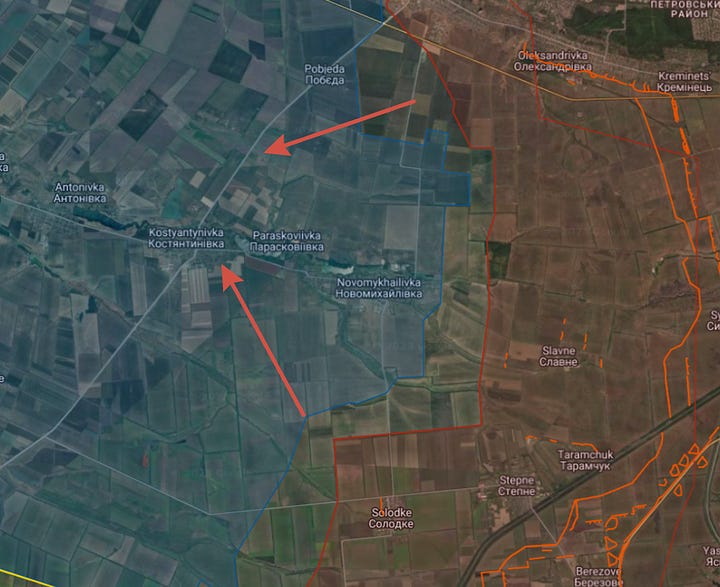
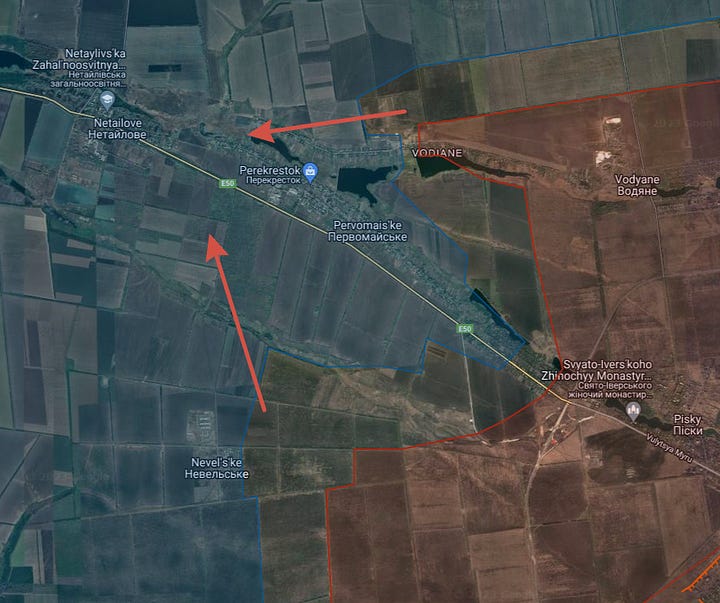
These assaults were clearly feints meant to scramble Ukrainian regional reserves to the defense. We have no real way of knowing how successful they were at doing that. But we do know for a fact that Ukraine has scrambled major amounts of emergency elite groups to Avdeevka in general.
Not only have I reported previously on the exact brigades but new Russian drone footage shows that even the most advanced Leopard 2A6s have been rushed to Avdeevka to help in the defense, a testament to the criticality of the front:
Also, Zaluzhny was pictured visiting a bunker in the Avdeevka front just like he did at the height of the Bakhmut battles, which demonstrates the front’s significance to the AFU.
Judging by the above we know that Russia’s Avdeevka plan was at least to some extents well planned and coordinated. It wasn’t just a spur of the moment local commander’s whim to launch a few companies into the assault.
However, there are many factors that are invisible to us which would serve as true indicators of how well of a coordinated effort it was. Things like the use of EW systems, how well-integrated Russian airpower is in the assaults. Are there any efforts to simultaneously disrupt rear lines with special operations forces via some kind of covert infiltration, whether it’s air assault landing, etc.? We know that type of thing is next to impossible in a peer-ISR environment, at least not without expecting great losses during mission planning, but it’s still something that should be looked at or at least attempted by a competent high level military.
Getting back to the opening bocage warfare, one of the main axes is the northern field leading toward Stepove. New footage is making the rounds on pro-Ukrainian sites claiming to show “total destruction” of Russian forces crossing this field to occupy the hedgerow:
This is geolocated here: 48.19957605794059, 37.70067711641808 at precisely this field:
Once more we see a column approaching in a single file line. This is for purposes of avoiding the minefield and appears to be the only semi-workable solution toward approaching an enemy position in modern mine-intensive warfare. It’s the same tactic Ukraine attempted to use in the infamous Zaporozhye-Rabotino Leopard 2 pile-ups.
In the video above we can see pure carnage—the quintessence of the modern battlefield. There are drones, artillery, mines, ISR everywhere, no where to hide. It’s brutal, there’s no denying that. This is exacerbated by the fact that the landing spots on the treeline are all zeroed in or “pre-registered” by Ukrainian artillery systems. That means they have those spots already calculated into the gunlaying solutions and must but wait for Russian forces to approach, then instantly pinpoint the landings with accurate strikes.
The video is being used by Ukrainians as an example of the ‘disastrous incompetence’ of the Russian army, and is said to show a massive destruction. But that’s clearly not the case.
1. Firstly, we can see there’s almost no armor losses. The armored vehicles appear to carry out their various duties in bringing troops to the landing zone which is this treeline:
2. Secondly, the video lies at the end and says Russian troops are “retreating”. In fact, this assault happens at dawn and if you study the light and shadow patterns, you can clearly see that the Russian troops are in fact heading toward the treeline because in the morning, the light is coming from the east. In the first second of the video you can even see the sun in the east:
Now watch the end where the troops are “retreating”:
The position of the drone has changed because it now has the sun more at its back, the red arrows indicate the direction of the light. You see the trees are being illuminated because they are facing the sun. The troops are going in the direction that the sunlight is shining toward, i.e. west, which is the treeline.
In short: this was a successful landing operation under massive artillery and drone bombardment. There’s nothing here to criticize the AFU about other than their unintelligent Twitter lackeys being forced to lie about the small loss. The AFU themselves did everything perfect here, even choosing the correct projectiles as you can clearly see the use of cluster munitions against exposed troops, which is exactly what you’d want to use against them.
That’s the whole point: this offensive is extremely difficult because the AFU is fighting very competently, and is dug into supremely difficult reinforced positions. But it’s a lie to say that the advance was “destroyed”—at the end of the video there’s not a single destroyed piece of armor visible. Furthermore, the choppy edit deliberately cuts out the various lines of successful troop landings that capture the treeline but only includes a few exposed troops at the end who likely had their transport damaged.
Also, not every armor advance’s goal is to actually make an ‘advance’ or successful push or capture of territory. Particularly in heavily fortified areas like Avdeevka where actual concrete-reinforced caponiers and other such systems are widespread, some armored advances’ sole job is to basically “work on” the fortifications until depletion. I.e. they come out, shoot and blow up the concrete fortifications, then once their ammo is out, they go back to base. However, in doing so, they will often have a landing force that comes with them to resupply, rotate, or reinforce the hedgerow trench system with more manpower. Here’s how this looks—actual footage of Russian tank wailing on Ukrainian revetment in Avdeevka from today:
The point is that just because an armored column ‘turned back’ doesn’t mean it was ‘defeated’. It clearly appeared to complete its job here, and UA’s disingenuous use of colorful ‘editing’ tricks in the videos doesn’t allow that complete story to be told.
Of course it was confirmed this treeline and field were fully captured, with some reports claiming Russian forces took positions even further west beyond the treeline, though there’s still no confirmation of that:
The key to success in this tactic, is that there has to be very tight coordination not only in the combined arms forces on the ground, but in every domain: in the rear artillery/drone forces, in the EW both offensive and defensive (intercepts, etc.), in the airforce.
As the column approaches and Ukraine begins to open up all those artillery systems on them as you saw in the video, these enemy artillery positions have to be swiftly identified in real time by allied counter-battery radar systems, drones, etc., and relayed quickly via Russian Recon-Fire-Complex methodologies in order to be suppressed. There’s not much time to do this because the column is under active fire. It can’t just sit there and wait. Every minute lost means men killed by all those cluster munitions.
To this day, the chief complaint on the ground continues to be not fast or effective enough relays of this sort. That’s because it’s extremely difficult to do because it’s also not just about artillery. There are a variety of enemy systems including mortars, AGS-17 style launchers, drones, hardened heavy guns firing things like 30mm, or ZU-23-2, 57mm S-60s, etc., none of which can be identified with traditional counter-battery radars and must be suppressed by other means.
There are other Ukrainian videos showing actual losses, this around the even hotter Slag Heap or ‘Terrikon’ front. Note the sheer scale of Russian armored columns being deployed as an emblem of the seriousness of this offensive:
A few things though:
Once again, there’s very choppy editing that attempts to skew everything in Ukraine’s favor.
Sure, there’s a few light armor losses, but how many actual manpower losses does it represent? Not many, because in almost all cases Russian dismounts survive and escape unharmed.
Here you can see where the fighting is taking place:
Red is the edge of the Slag Heap, purple are those dumping pools, and yellow is the curved road:
To zoom in, it seems that much of the armor went off road to this spot here right next to the Slag Heap:
Once again, there are some losses but the Slag Heap was now confirmed as fully captured by Russian forces. This is devastating to the AFU because it gives incredible fire control over the entire Avdeevka ‘valley’, including the MSR (main supply route).
But the big question is, are Russia’s putative ‘losses’ worth the miniscule gains they’re making? Pro-Ukrainians have stated that despite their massive losses in Zaporozhye, they did in fact gain a decent tract of land in the form of a bulge toward Verbove and one toward Urozhayne on the eastern Vremevske side.
Pro-Ukrainian accounts continue to emphasize their points by posting cherry-picked ‘updates’ from Russian doomer accounts who criticize the Avdeevka operation. For instance, a popular one going around is a new critical post from Russian TG channel Grey Zone which argues that Russia is “wasting its mobile formations” and claims Russia lost more equipment than Ukraine’s entire Zaporozhye offensive:
But this is why you need a capable analyst to separate the wheat from the chaff. The pro-UA pundits fail to divulge that Grey Zone is a Wagner-affiliated channel that’s famous for being highly critical of Russian operations, particularly during the Bakhmut saga. They were one of the doomers who cried daily with Prigozhin about how ‘terrible’ everything was, how Russia would never win or capture Bakhmut, etc. And what happened?
This is why true, accurate analysis takes more than just being able to do a cursory search for quick, cherry-picked ‘dunk’ material that bolsters your point. You have to know the histories of the voices involved, their credibility and past track record, whether it’s proven or not. Why would you trust a source which has already verifiably discredited itself?
Let’s see another. Here’s a pro-UA analyst channel with a detailed writeup about what they believe is a disastrous offensive, but there are several key flubs that once more demonstrate the Ukrainian side’s disingenuous narrative-skewing. It’s longer so I’ll break it down by section and add comments to each:
TG Channel "Spy's Dossier" wrote the following scathing critique of the Russian command concerning their planning and execution of the offensive to capture #Avdiivka:
🔓Avdeevka. Subtotals.
The tenth day of the offensive operation in the Avdeevsky direction is coming to an end. Let me give a brief outline of what is happening on this section of the front, compiled on the basis of comments from military personnel participating in offensive combat operations.
In the minds of the command of the Russian Armed Forces, the Avdeevka operation was planned as something very cunning in a military sense. The plan was to rapidly advance with an armored fist from two directions to cut off the main group of the Armed Forces of Ukraine in Avdievka itself for the further formation of a “cauldron.” Block the railway (north) and road (south) supply routes to the city. “Ironize” enemy forces in the city with artillery.
On the side of the Russian Armed Forces:
• high number of trained and fresh personnel;
• armored vehicles and artillery;
• possibility of using aviation;
• effect of surprise.
(This is exactly the list of advantages that was reported to senior management during the preparation of this operation).
They already start off with a lie. They claim the plan was for a “rapid advance” to create the pincer. Yet there’s much intelligence to the contrary, which shows that Russian commanders planned this as a long whittling operation. This fake uses the standard Ukrainian trope they created in the form of the infamous “3 day operation” to take Kiev. It’s basically a dog-whistle to their low intelligence followers, giving them something to celebrate.
In reality, if Russia wanted a very fast pincer, why go through the effort of that 10 prong mass, multi-fronted attack we spoke of earlier? They could have just accumulated all the man power on one or two pincers to give an “all out” push in hopes of this fast blitzkrieg style advance fantasy.
What actually happened? Let's briefly go through the points.
Personnel - indeed, units of the RF Armed Forces managed to accumulate a relatively large group in this direction. And indeed, these are not battle-weary military personnel. The question is - is this good? The recruited personnel represent fresh reinforcements for military units that suffered losses during the Northern Military District. In fact, “unfired”. For a significant portion of the military personnel, this is their first battle. Moreover, both for privates and non-commissioned officers. Throwing them into such a complex offensive operation right away is a controversial idea.
Here they at least admit to the fact of it being a complex operation, which we spoke of earlier.
Armored vehicles and artillery - here I would like to note the “genius” of the very idea of breaking through with an armored fist. The planning of the operation was entrusted to stupid morons, “carpet” generals and colonels, who saw the war only on maps in their offices. Brought up on the Soviet doctrine of “armored breakthroughs” from the Second World War, they were not smart enough to realize the suicidal nature of this plan. Result? 63 lost pieces of equipment, as of yesterday, and these are only confirmed by photo/video recording (here are various modifications of armored personnel carriers, T-72, T-80BVM, MT-LB, etc.). Why? Low efficiency of the CBB, due to the shorter firing range, lack of ammunition supply, and a large number of ATGMs in the Armed Forces of Ukraine. Separately for ammunition supply, the supply of shells in some places reached less than 10% of the norm. LESS THAN 10% for an offensive operation.
Aviation - again, by wishful thinking, the “carpet generals” only harmed their own troops. The General Staff of the Armed Forces of Ukraine claims that over the past ten days, they managed to shoot down at least 5 aircraft of the Russian Armed Forces. The activity of the Ukrainian air defense significantly limits the capabilities of the Russian Armed Forces in covering the armored advance. And without this, what is described above happens. Also, it is worth noting the regular combat sorties of helicopter aviation of the Ukrainian Armed Forces towards the collision line.
Here again they play to a popular trope dogwhistle—that of Russian ‘carpet generals’, a term Prigozhin popularized in his endless diatribes against the MOD. No where was it apparent that Russia intended an ‘armored fist’ to break through anywhere. In fact, the armor was used to capture key objectives meant for staging a next, subsequent phase of the operation.
For instance, the most obvious being the Slag Heap in the Krasnogorovka direction. Why would an armored fist want to “break through” past there into an open killing field? There is no evidence whatsoever that they even tried. The whole point was to capture the Slag Heap in order to now cover future advances with a massively advantageous elevation, which they succeeded in doing by all accounts.
The other biggest lie which discredits the rest of the report, is that they shot down “5 Russian planes” in the past few days. There’s not a single credible report of a Russian plane being shot down—such desperate fantasy just proves that the rest of their ‘analysis’ is likewise made up. In fact, to the contrary, there were reports Russia shot down several Ukrainian aircraft, including one confirmed video of a helicopter.
The effect of surprise - there is nothing to comment on here. To believe in the possibility of secretly accumulating forces and means in the era of satellite technology is to be a graduate of the Soviet school of military affairs.
This is their only important and valid point, which underscores what I’ve been saying. It is in fact impossible to accumulate any large scale ‘surprise’ strikes, which means the only way to advance is not to rely on some magical ‘surprise’ armored breakthrough, which utilizes a brief window of your enemy’s unsuspecting confusion to strike past them to the rear, and potentially surround them. But rather, since both sides know where the majority of each other’s forces are, advancement can only be successfully made by way of a step-wise, progressive accumulation of a number of smaller tactical victories in the capture of key tactical positions which gradually weaken your opponent’s ability to defend the sector.
In the case of Avdeevka, Russia is doing just that by securing fire-control over the MSR (main supply route), which will now make life extremely difficult for the AFU defenders. It’s a slow, progressive strategy because it relies on whittling down the defender’s supplies by way of that MSR fire control, which creates a gradual ammo shortage over the course of weeks, that will begin to impact the AFU’s effectiveness in repelling future armor pushes.
Are there any positive results for the RF Armed Forces? Eat.
First, as of the evening of October 18, there was a slight advance of the Russian Armed Forces in the area of Vodyanoye in the south and Krasnogorovka in the north. Was this the result expected on the tenth day of the offensive? The question is rhetorical.
Secondly, (further from the words of a serviceman of the Russian Armed Forces in this direction) the work to intercept enemy radio messages is noted positively. But there is also a lack of prompt response to interceptions. For example, my interlocutor’s unit recorded information about the discovery of a group of personnel of the Russian Armed Forces and the preparation of a fire crew of the Armed Forces of Ukraine to strike this point. Despite the transfer of this information to the command, there was no prompt response, and the personnel came under enemy fire.
@dosye_shpiona
Finally, they admit to the successes we talked about so their entire argument appears to revolve around: “Russia lost because they didn’t capture all of Avdeevka in 3 days (a completely made up objective timeline) and they took a lot of armored losses (which are vastly exaggerated by about 5X).”
A last doomer account at least notes something strategically important:
There is no need to talk about successes on our part. The entire theater of military operations consists of 4 forest plantations. If they manage to knock the enemy out of the line of defense, then they completely destroy all the trenches with artillery and tanks. After such shelling, the position becomes impossible to hold. All that has been achieved at the moment is moving the positions of the Ukrainian Armed Forces away from ours and increasing the gray zone.
This emphasizes the point I’ve made—that destroying one treeline position of the bocage at a time creates a situation where your own forces cannot occupy that position because the fortifications there (for instance the trench cover/roof, reinforced walls, etc.) are gone. That means your troops will have to rebuild the fortifications under return fire, potentially of the cluster variety that stands to wipe them out.
Here’s an alternative Russian source on Avdeevka:
There are a lot of questions about Avdeevka. I will say this and repeat myself again: there is a mode of silence (minimal reports), allowing our boys to work quietly. Moreover, this is on the initiative of the soldiers there, on the ground. This shows that what guys really need is silence.
As for the general situation, believe me, at the moment it is not in favor of the Ukrainians.
Yes, there are losses. Yes, the enemy uses every opportunity in the information field to sow panic and doubt in the minds of our citizens. If you feel these feelings, then you have become the target of an information war.
Now the Ukrainian Armed Forces are pulling together several brigades in this direction, bleeding others dry. Heavy equipment, electronic warfare, and artillery are being assembled. They really want to knock the Russian Armed Forces out of the waste heap, because this is the key to Avdeevka.
But why don’t we turn to what actual Ukrainian fighters on the ground are saying, rather than clueless propagandists on Twitter and Telegram?
The above states the situation is very ‘difficult’ for them and that Russia’s new assaults are as powerful as the very opening ones from the first day. How can that be if they lost hundreds of armor pieces and their brigades were entirely devastated as Ukrainian accounts claim? Also recall in the previous post, the UA propagandist claimed Russia had 10% low ammo and things of that nature—that’s hard to reconcile with several Ukrainian reports of extremely powerful renewed attacks ongoing now.
Here’s another:
👉 Ukrainian Post
The situation is worsening in the Avdeevka region.
The worst is near the tericon (slag accumulator of AKHZ) and in the direction of Severny.
Yes, the enemy's equipment is on fire by the dozens, but the occupiers are still succeeding. The question is that they do not get fixed, which is what ours do.
And here’s the most devastating:
Yes, you read that right. The Ukrainian soldier’s account states they are losing 1,700 men per day in Avdeevka. And that’s KIA.
In fact I already showed last time that reports indicate Ukraine is suffering greater armor losses even than Russia’s exaggerated ones:
Recall that the respected Ukrainian reserve officer and military analyst admitted two days ago that most of Russian “losses” are in fact old armor (and probably belonging to Ukraine anyway) from long ago battles:
The reason this is the case is because unlike other frontlines, Avdeevka has been in a static position since almost the beginning of the SMO. Yes, Russia’s position in Krasnogorovka just behind that Slag Heap was the same line of contact from middle of last year. That means for a year and a half there have been on and off tank battles on that exact patch of land that Russia is now attempting to advance out of.
So for instance, when you see a video like this one I posted much earlier in the article:
Much of that circled armor is months old, and in the closeups it’s often fairly easy to tell the freshly destroyed apart from the blackened, rusted hulls which have been sitting for half a dozen seasons.
This is in contrast to frontlines like that of Verbove, where you see dozens of destroyed Ukrainian armor units right near Russia’s Surovikin line. We know for a fact the frontline was not close to there just a couple months ago which means all that armor is freshly destroyed as they began to approach the Surovikin line.
Here’s a map dated April 6, 2022. Yes, not 2023, but 2022:
The red circle is the Slag Heap for point of reference. You can see the frontline is almost identical. The red X’s are where we could expect fighting to have happened literally for the past year and a half, accumulating destroyed armor from both sides. In fact, I already reported last time how one Ukrainian account was caught posting footage from early 2023 that was geolocated to roughly that area and trying to pass off the losses there as from the current battle.
In fact, I recall earlier this year reporting on a Russian assault which struck out toward Stepove-Berdichi and managed to lodge itself there for a few days but was later beaten back. That means the back and forth over this area has verifiably been going on.
This is why one can’t take Ukrainian claims of losses seriously in the Avdeevka theater.
The only thing giving the semblance of a disparity is the fact that Russian forces are observing strict OPSEC and not posting as many videos of Ukrainian losses. Recall that we were spoiled in Bakhmut with daily accounts of vast UA losses because Bakhmut was primarily prosecuted by Wagner, a mercenary outfit with its own relaxed rules.
Zaporozhye we saw many videos of AFU destruction as well, but I have a feeling that’s because Russia was on the defensive, and thus there isn’t as much “OPSEC” to worry about because you’re not really giving away your offensive plans. They were simply sitting by as the enemy came to them and released videos of the aftermath and were rarely in great danger since the defender has such unique advantages.
But in Avdeevka, it’s extremely serious and dangerous because of the major challenges attackers face in such a peer ISR environment, so I can only assume this is why OPSEC is stricter than ever.
That being said, we still have some videos being released showing Avdeevka from Russia’s POV that underscore Ukraine’s losses. There were a couple videos showing Russian forces capturing Ukrainian trench positions:
(Blue=AFU, Red=Russia)
🇷🇺🇺🇦 Capturing the position of the Ukrainian Armed Forces in the direction of Avdeevsky.
In the Avdeevsky direction, a separate reconnaissance and assault detachment “Cluny” of the Volunteer Corps of the Southern Group of Forces carried out a successful attack on a fortress of the Ukrainian Armed Forces. Thanks to the skillful actions of the military personnel, the position came under the complete control of Russian troops.
And another from today:
As well as 2 Ukrainian tanks destroyed today by Sparta battalion FPVs in Avdeevka and AFU troops destroyed by drones beneath the train tracks near the Slag Heap here and here:
I posted slightly older other ones previously, like this from days ago showing many dead AFU in captured trench positions. There are many other videos of solo tank and artillery kills which add up to dozens of units.
Furthermore, the Russian airforce is said to be dropping an immense amount of ordnance on Ukrainian positions there which is certainly leading to massive losses. That’s because even though they’re fortified, that was also the case in Azovstal. And we found out afterwards from Azovstal survivors that those airstrikes were inflicting miserable casualties on them, killing dozens at a time with each strike.
🇷🇺⚔️🇺🇦 The Avdeevka area is now subject to intense air attacks for an hour, in addition to regular artillery shelling and MLRS attacks.
A wide line of Ukrainian fortifications in the region are hit by 500 to 1,500 kg of bombs approximately every 15 minutes
In fact, though it doesn’t pertain specifically to Avdeevka, this new Ukrainian post gives an idea of just how large Russia’s air campaign has been recently:
They complain that Russia will have dropped over 1,000 UMPK glide bombs just in October alone, many of those on Avdeevka. They acknowledge that Russia has massively industrialized the production of these bombs and it will only continue to increase. This contributes to why I do believe Ukraine is suffering vastly more losses in Avdeevka than Russia. It’s outgunned in every way—and 3-4 videos of a couple destroyed Russian BMPs and APCs is just a drop in the bucket of the losses that Russian firepower is inflicting on the AFU. It’s the same tale as in Ugledar—we were shown a small destroyed column, amounting to maybe a handful of men lost, and were told this represented “thousands of Russian KIA.” Later, MediaZona revealed that an indepth study of obituaries showed Russia lost only around ~100 total men for nearly the entire month there.
Let’s examine a last couple items. You’ll recall last time I posted updates from a fighter on the southern Avdeevka grouping. He’s amongst the group capturing the “Royal Hunt” as some are calling it, or Tsarska Okhota point here:
They’re the group that captured the highway overpass in the video I posted last time.
You’ll recall this fighter made the rounds by first complaining that they were “stuck” and couldn’t advance anymore. But each successive day’s posts improved. This is his latest post:
DAY ELEVEN
At night, the enemy was preparing to launch a counterattack to recapture the fortification we had occupied, but the adventure failed. The group was burned and worked with "Tulip". (Ed: 2S4 Tyulpan 240mm mortar system)
Welcome again, we are waiting for you. The day passed in a counter-battery fight. The level of modern reconnaissance means does not allow a covert approach, all movements are detected, groups are covered with artillery and anti-aircraft guns.
However, we have one idea. Time will show. Yesterday the neighbors on the right occupied two fortifications. In the north, our troops again recaptured the key waste heap and reached Berdychi.
Now the most urgent thing is not to allow the Germans to transfer reinforcements from other directions. Well, keep going. The fights are very brutal. Near our site today, an enemy FPV drone destroyed a civilian passenger car. There were a man and a woman in it. The man died on the spot. Our FPV specialists gave the machine-gun crew a nightmare and did not allow them to work.
The battle for Avdiivka is already being compared to the Bakhmut meat grinder, but this is not entirely correct. On the one hand, flanking and encircling Avdeevka will determine the outcome of this battle. On the other hand, the approaches are fortified in a way that, perhaps, no other section along the entire Donetsk front is fortified.
The miracles of heroism now lie not in moving forward, clearing trenches, but in simply holding on. And we do this every day. Please pray for us.
My call sign is Leader.
Victory will be ours!
source: Vozhak_Z
Let’s break it down:
Firstly, again an acknowledgment that no type of ‘covert approach’ or surprise attack is possible in today’s ISR heavy field. That means every advantage must be won by small tactical gains in the same way as chess. Moves in chess are made in a very slow and telegraphed manner, your opponent having time to think and “see” everything you’re doing. Often he can compute your exact plan but it’s just a hair too late, as you’ve already started a cascade of moves from which he can no longer recover owing to one of your previous “!!” moves having ‘wedged’ your attack into his piece-structure in such a way as to critically endanger his entire positioning.
Intriguingly, he mentions having some trick or idea which they are currently working on that would presumably nullify the above. The reason that’s interesting is because just today came reports from Ukrainian channels that Russian forces are now “digging tunnels” toward Ukrainian positions on Avdeevka so as to bypass certain heavily fortified zones and “pop out” in surprise.
Frankly, I had no clue what this could even mean. How can you dig a tunnel under a battlefield in real time? But it makes me wonder if this is the “trick” that the above fighter was referring to. It could be something smaller and more local—not some grand 5 mile tunnel. And in fact the ‘tunnel’ report was from the AFU’s 110th Mechanized, which is inside Avdeevka city itself—rather than outlying positions like Berdichi, etc.—not far from the Russian fighter’s position near ‘Royal Hunt’, so it is plausible they’re referring to the same thing.
The other thing he seems to confirm is that Russian forces did in fact reach the outskirts of Berdichi. This is something that has still not had any confirmation but we continue to here some sources report.
Recall that we analyzed the video earlier which showed Russian forces capturing the treeline in the purple box below:
Berdichi outskirts are just one or two further fields past that where the yellow line is pointing. It’s plausible that some Russian group managed to ensconce themselves somewhere in that next field’s tree line.
Yuri Podolyaka has the following analysis and update:
Yuri Podolyaka: Avdeevka: situation at 18.00 10.23.23
Today is artillery day. Both we and the Ukrainian Armed Forces are working along the enemy’s front line and the immediate rear, trying to disrupt the enemy’s logistics and his ability to accumulate reserves in the front line.
Moreover, the activity of our “art” is noticeably higher, which indicates the seriousness of the intentions of our command. Unlike artillerymen, infantry (ours and the enemy) are not active today.
Ours (while the artillery is working and the sappers are making passages in the vast minefields that surround Avdievka) continues to consolidate on the achieved lines (and, probably, a regrouping is taking place before the next breakthrough).
The enemy is trying to rotate the front line and bring in ammunition, but he succeeds with difficulty (and losses). Doesn't launch counterattacks. In general, the situation is clearly pumping up, and the next surge of activity will not be long in coming. Analytics by Yuri Podolyaki
Again we hear confirmation that artillery is in fact working powerfully and is not experiencing some sort of shortage. The pause is made to consolidate gains and have sapper teams clear further passages so a new assault phase can resume. This is all standard procedure. Why would anyone expect that Russia planned a mad 3 day dash to conquer the whole front as the propagandist from earlier had implied?
No, this is a clinical, methodical break down of an entrenched enemy’s cauldron. To have fire control over an enemy’s MSR is to inflict a constrictor snake’s slow strangulation. Note how Yuri states that even their counterattacks are now dwindling. These are natural consequences of having your supplies slowly choked out, forcing commanders to switch to a purely defensive regimen rather than ‘active defense’ where you can allot a given percentage of ammunition toward minimal outward assaults.
They’ll never run out of artillery because the artillery batteries fire from many kilometers away, outside the scope of Avdeevka’s ‘cauldron’. But the forces inside the cauldron will in time begin to run low on critical items like mortars and ATGMs. Once you’re low on ATGMs, guess what that means? Russian armor pushes will begin getting more and more aggressive and successful. It’s a low boil, constrictor tightening—textbook style.
As a final confirmation of that point, let’s take a look at one last analysis, that of retired American artillery officer ArmchairWarlord. He provides this helpful elevation map that also outlines Ukraine’s one maine supply route (MSR) out of Avdeevka:
He believes Russian forces will concentrate on Stepove and “Royal Hunt” as he considers Severnoe to be a “hornet’s nest”. It’s hard to say for sure if that’s the case, but given the fact that Russian attacks from that southerly direction have been smaller does seem to suggest that axis was more of a feint or distraction, with the Stepove/Slag Heap direction being the main front.
One of the reasons is the Slag Heap is critical for fire control over the MSR. I noted last time how we’re entering the muddiest time of mud season presently. New videos like this from today suggest it’s already getting bad in Ukraine in general:
That means even a minor pressure on that one and only MSR will be devastating to the AFU because the fields will be far too muddy to move equipment and supplies.
This is why I don’t necessarily see Russia rushing into envelopment, because they too will soon be affected in trying to cross fields with armor. One tactic would be to capture a few more strategically advantageous forward positions to secure fire control over that MSR and then lay back and switch to a more slow going attritional and positional mode. At that point, they can simply starve Avdeevka out with total fire control of the MSR and there won’t be any immediate need to completely shut the cauldron.
How much more needs to be captured to secure total fire control? It’s difficult to say without seeing the exact perspective from some of the positions to determine whether they have, for instance, direct line of sight to the MSR or not.
There are several types of fire control. Partial would be where the road is in artillery and mortar range via indirect fire, but is obstructed from direct fire of systems like ATGM. Ukrainian supplies would still be able to get by here and there as artillery is not accurate enough to stop all vehicles via indirect fire. But if you have good positions with direct LOS, then ATGM systems would have total fire control as they virtually can’t miss a target that’s visible to them.
I emphasize this because I saw a person ask: “Why is direct fire control needed (like for instance the position on top of the Slag Heap) when today we have drones that can see “over” obstructions?”
Yes a drone can see over it, but what is it going to do? If a drone sees a car traveling down the MSR, it can tell the rough coordinates to an artillery system which is firing from far away, beyond visual range, and will have very little chance of accurately slamming that car unless it’s firing laser guided shells, which are in short supply.
Of course now, there’s a sort of third ‘in between’ tier as you can maintain decent fire control with FPV drones beyond visual range, not needing direct LOS. But they too are not as effective as ATGM strikes via direct LOS.
If I had to predict the most critical moves to be made, and if I were commanding the theater, here’s what I’d go for.
First, capture Stepove and use it to bolster the capture of the field directly south, which overlooks the Coke Plant factory complex:
Using that hedgerow, establish trenches in order to create fire control and a suppressive fire cordon for friendly units coming from behind the Slag Heap.
Next, get your most experienced urban warfare storm units, preferably Wagner, etc., and using the cover of the Slag Heap, begin trying to lodge them into the outer most periphery of the Coke Plant:
There’s some indication that this is exactly what they’re doing, as this report came just today:
According to the enemy, the Russian Armed Forces assembled three full brigades for the assault on Avdiivka, excluding the Storm Z detachments.
Storm-Z is exactly the ex-convicts Russia likes to use in the most dangerous urban assault areas of this sort.
They need only to capture the first quadrant of buildings in the plant, which they can do by using the suppressive enfilading fire of the units entrenched in the hedgerow near Stepove, shown before.
Once they’re lodged into this first section of the Coke Plant, they will now have a very close and clear LOS to the one and only MSR out of Avdeevka:
Particularly given the fact that the Coke Plant has some multi-story complexes there, they will be able to put ATGMs, snipers, etc., into positions to completely lock the MSR in case the Slag Heap does not allow absolute fire control over it.
There’s many precedents before for Russian forces lodging themselves into large industrial enterprises even while the AFU is still in there, then slowly squeezing them out. In fact, Bakhmut itself was captured this way—here’s screenshots from a March 2023 report of mine:
Wagner gradually wedged their way into that plant and began developing southward. They can potentially do the same with this Avdeevka plant.
The fact that the Coke Plant is adjacent to the natural bulwark of the Slag Heap should allow Russian forces to push into it, if they can capture those northern positions near Stepove for maximum protective cover.
Once this is done, AFU will have no choice but to push through the fields heading toward Severnoe, for which there is one barely suitable, small dirt road. However, if Russian forces can push up from the south just slightly more to have full fire control over those fields and dirt road, then it will be completely game over.
This plan represents the least amount of actions, and smallest amount of territory covered in establishing a complete lock down. Why, for instance, go all the way to Berdychi, fighting through countless more fields and positions, when you can completely cut off Avdeevka in a couple more elegant moves?
So that’s how I see it unfolding, and barring access to real on-the-ground data, that’s how I’d seek to finalize the constriction and strangulation of Avdeevka. Let’s see if Russian forces follow this line of thought. If you see them beginning to strike out from their new positions in the Slag Heap toward the hedgerow just next to the Coke Plant, you’ll know this is exactly the plan they’re going to be following.
Ultimately we have to wait and see how much of this sticks as it’s still a dynamic situation. For all we know Ukraine may kick Russian forces back out of the Slag Heap and Stepove area and progress can suddenly stall. But for now, given the information that we know, I personally feel confident of the offensive’s direction thus far. Particularly given that we now have fairly high confidence assessments that the AFU is in fact taking higher casualties. I will confess that vehicular/armor losses are inconclusive, and it’s possible Russia is taking heavier losses than the AFU there, though I woudn’t be surprised if even this wasn’t the case.
But ultimately, the most important by far is manpower. That’s because Russian production lines are now pumping out armor like there’s no tomorrow, and that will never cease. Russia will continue to have ample stocks of that. Also it should be noted that by far the majority of losses are in light armor, BMPs and BTRs. This is particularly one area where Russia has an almost limitless supply as its pre-war stock was said to be literally tens of thousands.
Barring some sudden sharp cut in ammo supplies, I foresee Russia successfully continuing the encirclement operation. A sharp cut could happen. For instance, as one of the earlier quoted posts pointed out, offensives typically get a certain amount of elevated ammunition usage allotted to them for a given period, which could be a few weeks or a couple months at the most. Should that period pass without major successes or advances, then Russian forces could face a sudden curtailment that would bog them down.
So for now we’ll see, but we’ll keep following this front closely as it likely remains to be the most prominent area of operations for the remainder of the year, barring a sharp uptick in Kupyansk or Kharkov region.
If you enjoyed the read, I would greatly appreciate if you subscribed to a monthly/yearly pledge to support my work, so that I may continue providing you with detailed, incisive reports like this one.
Alternatively, you can tip here: Tip Jar


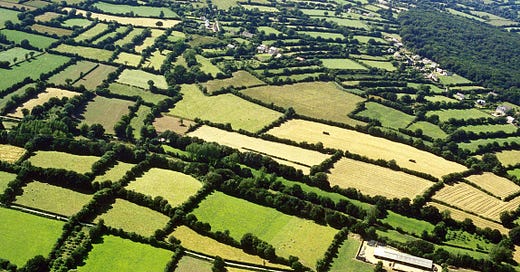



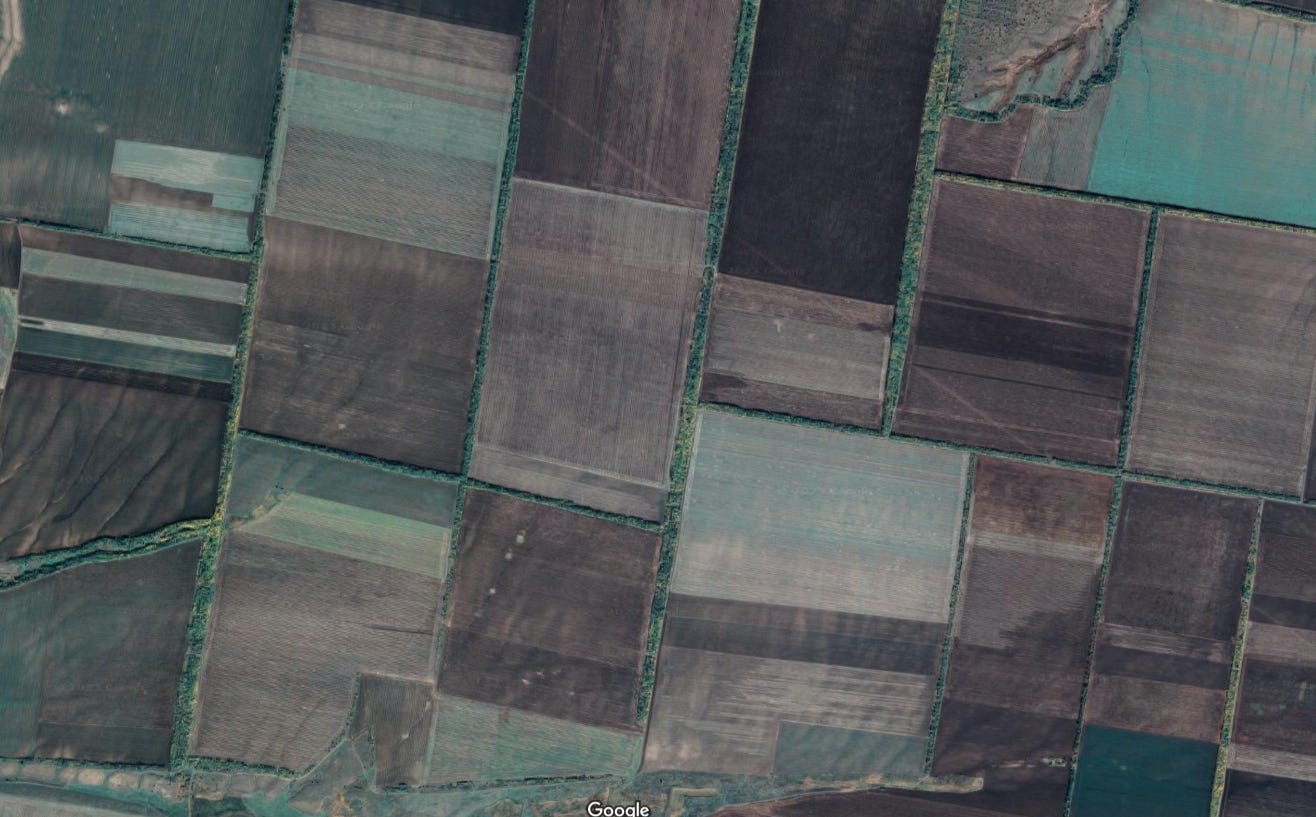
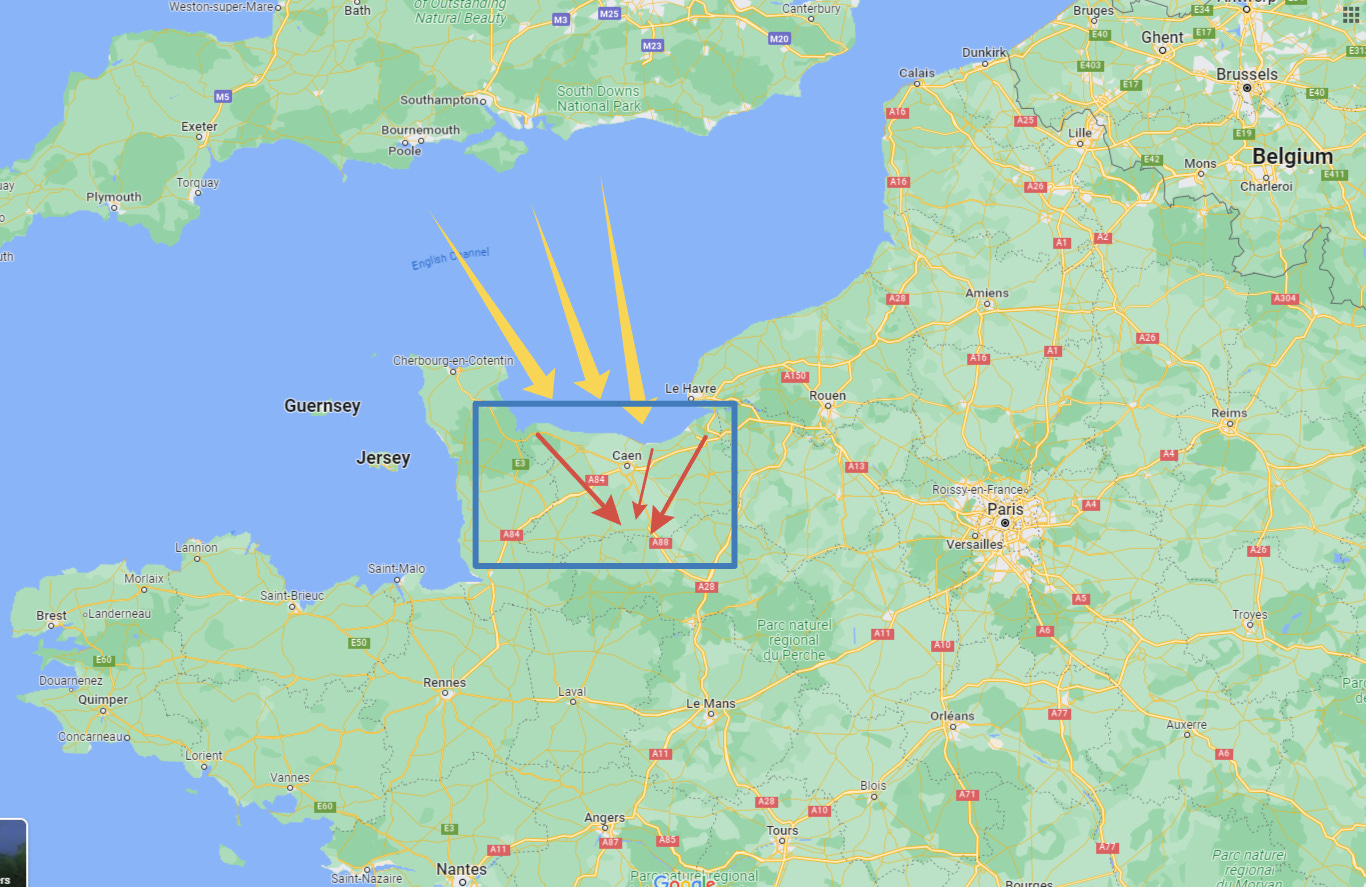
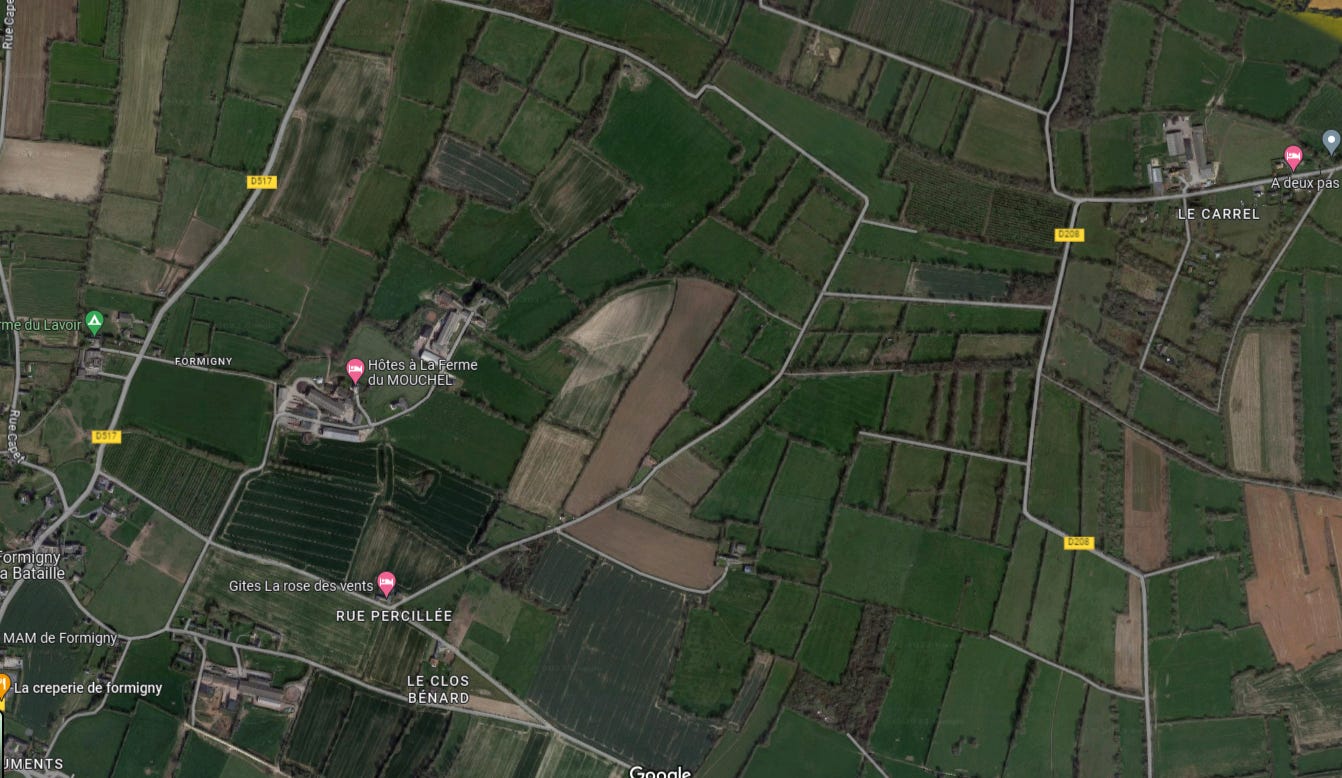

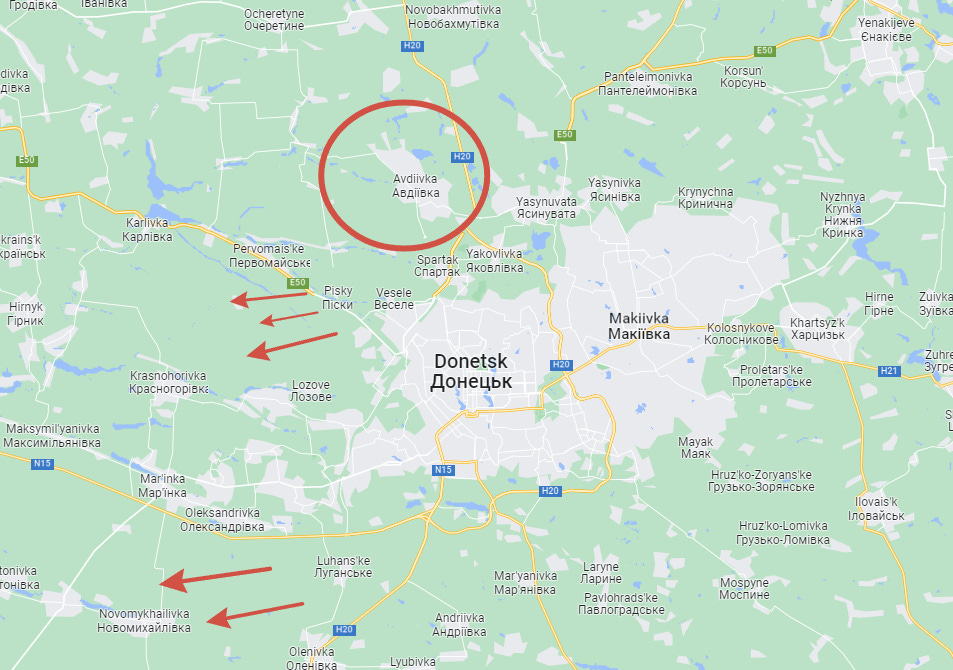
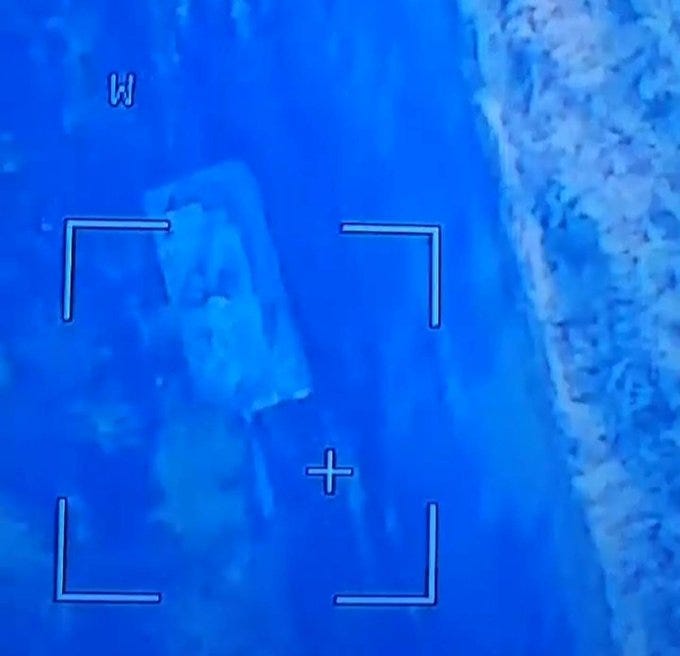
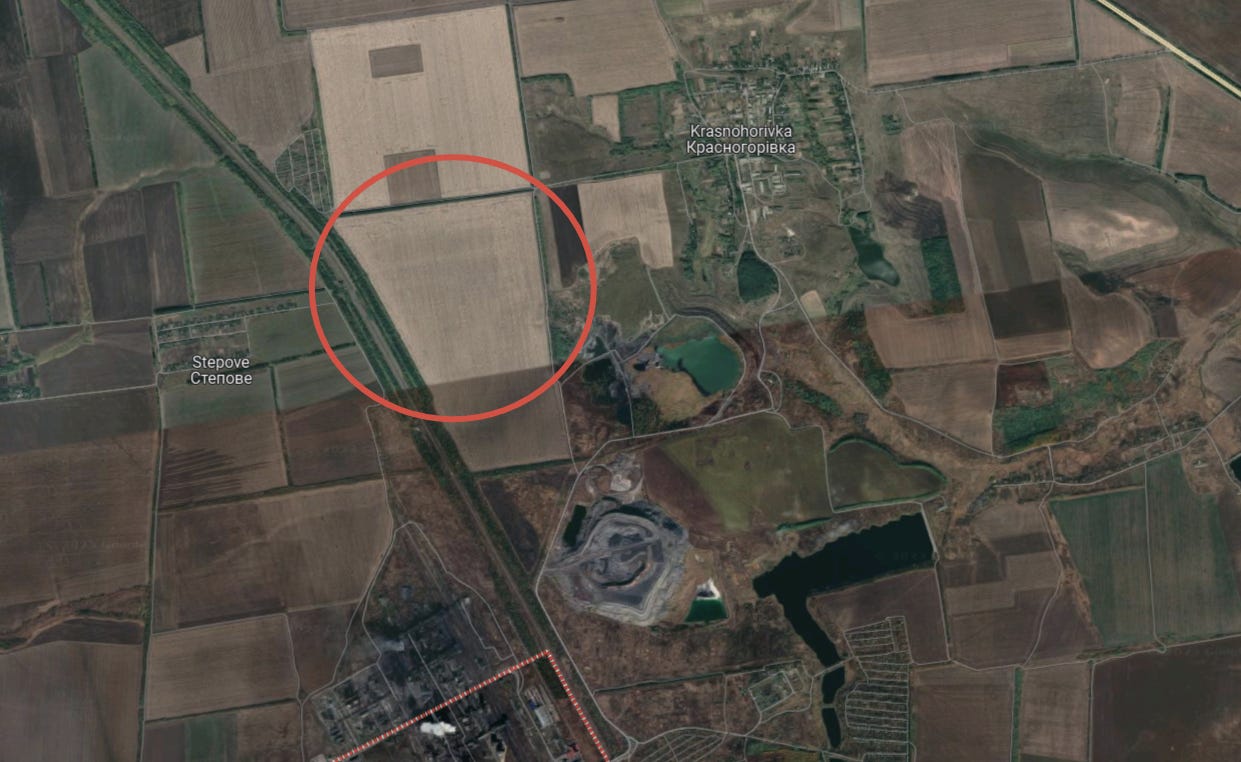
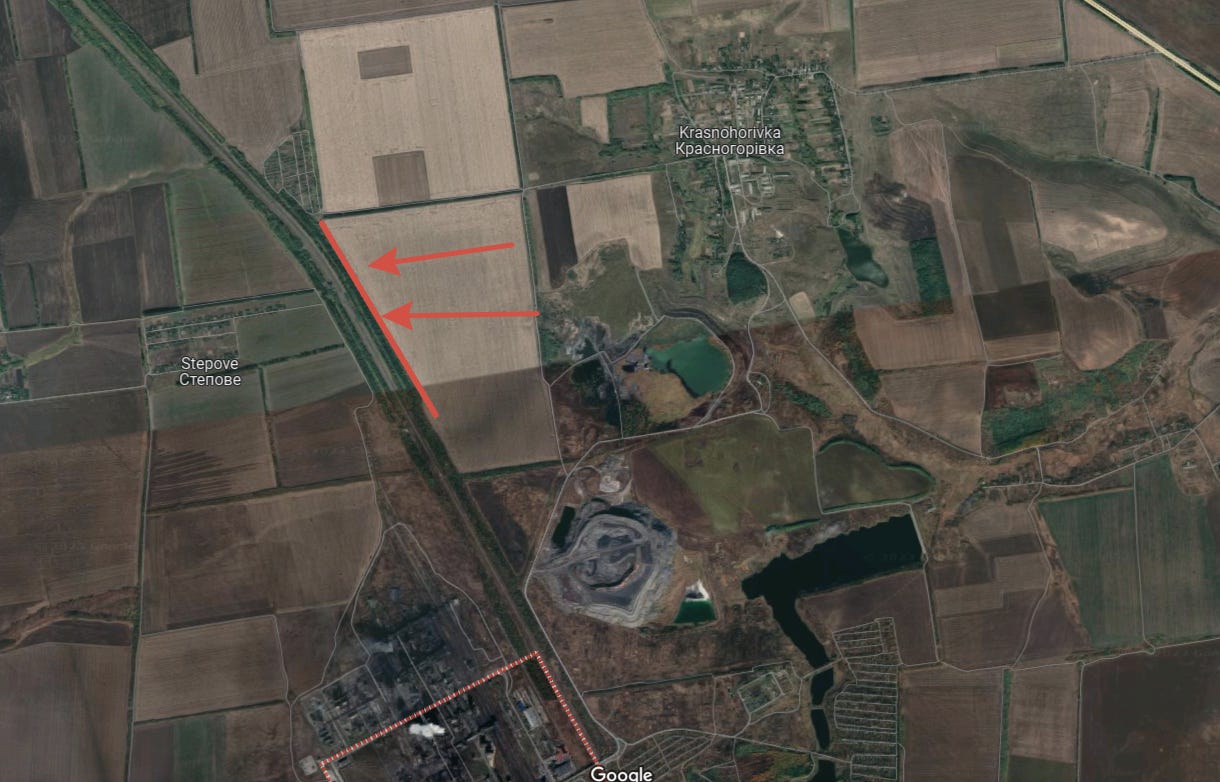
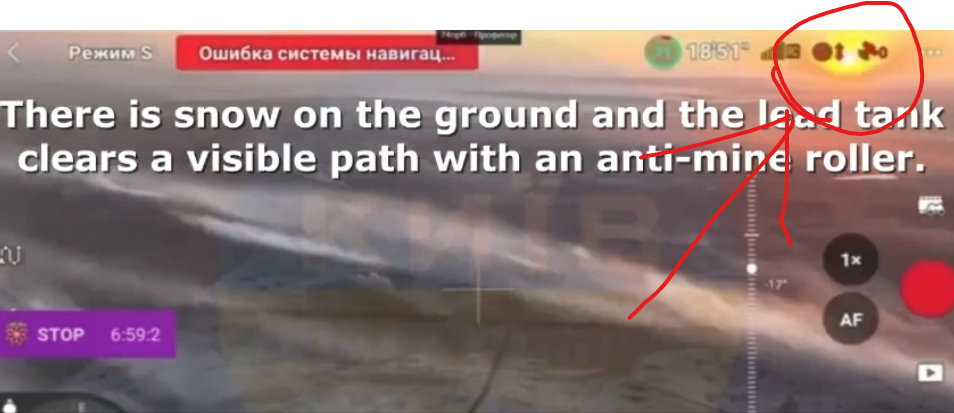
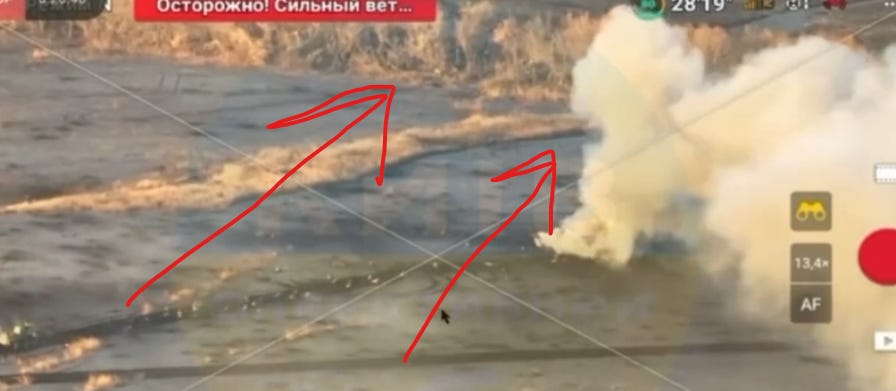
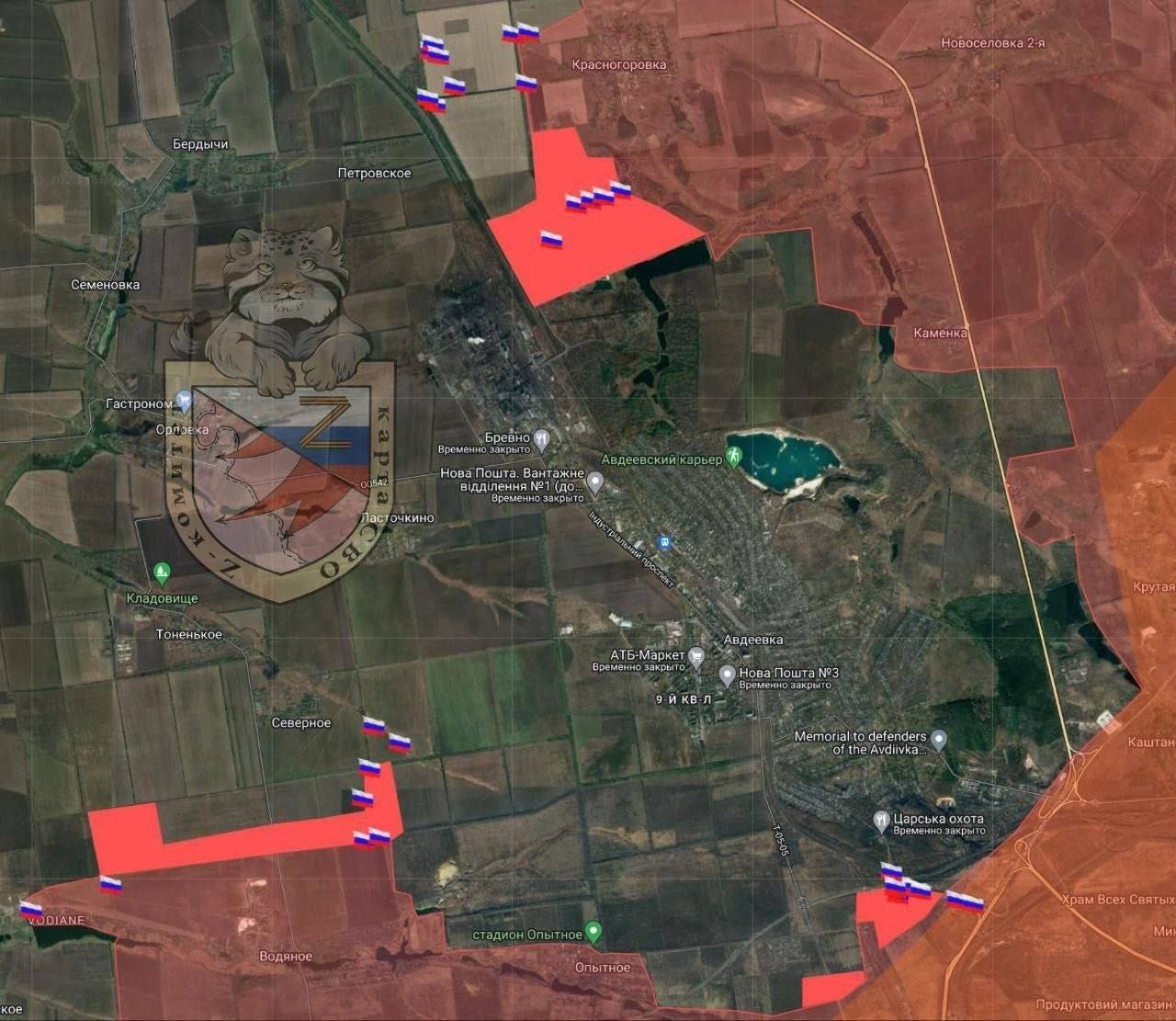
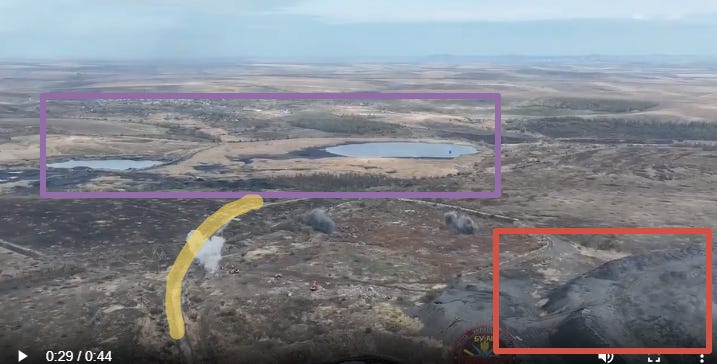
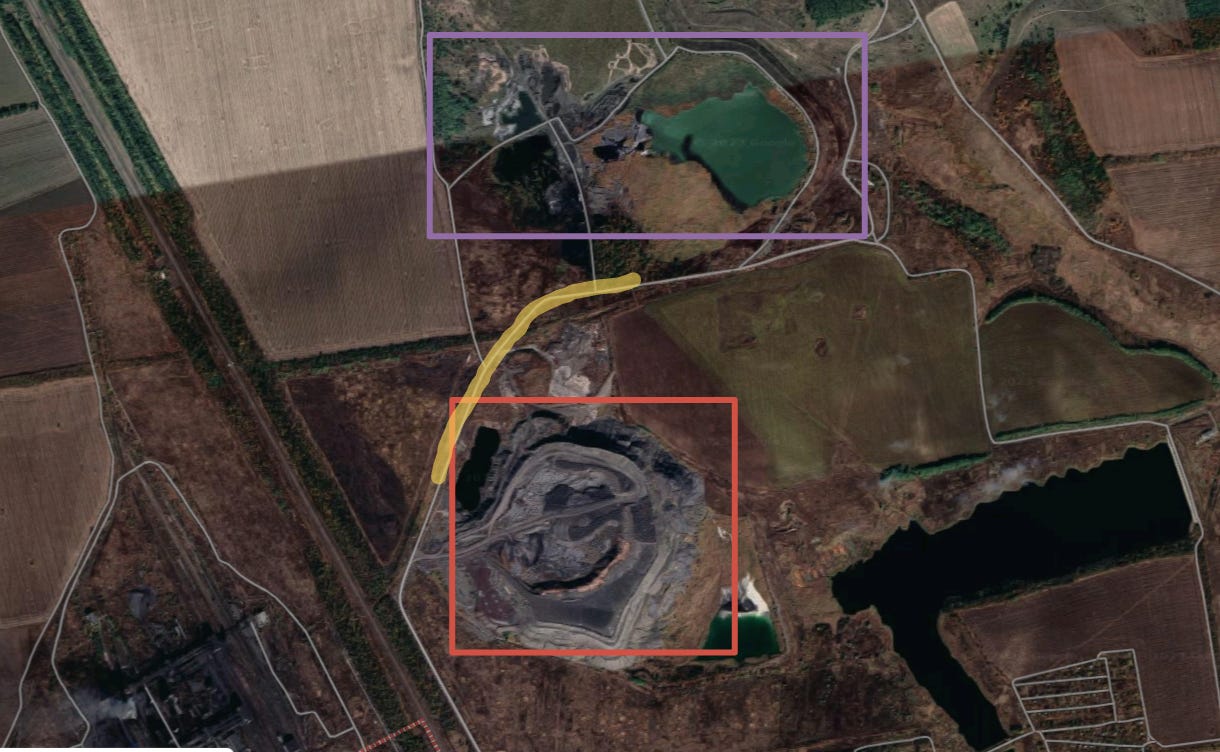
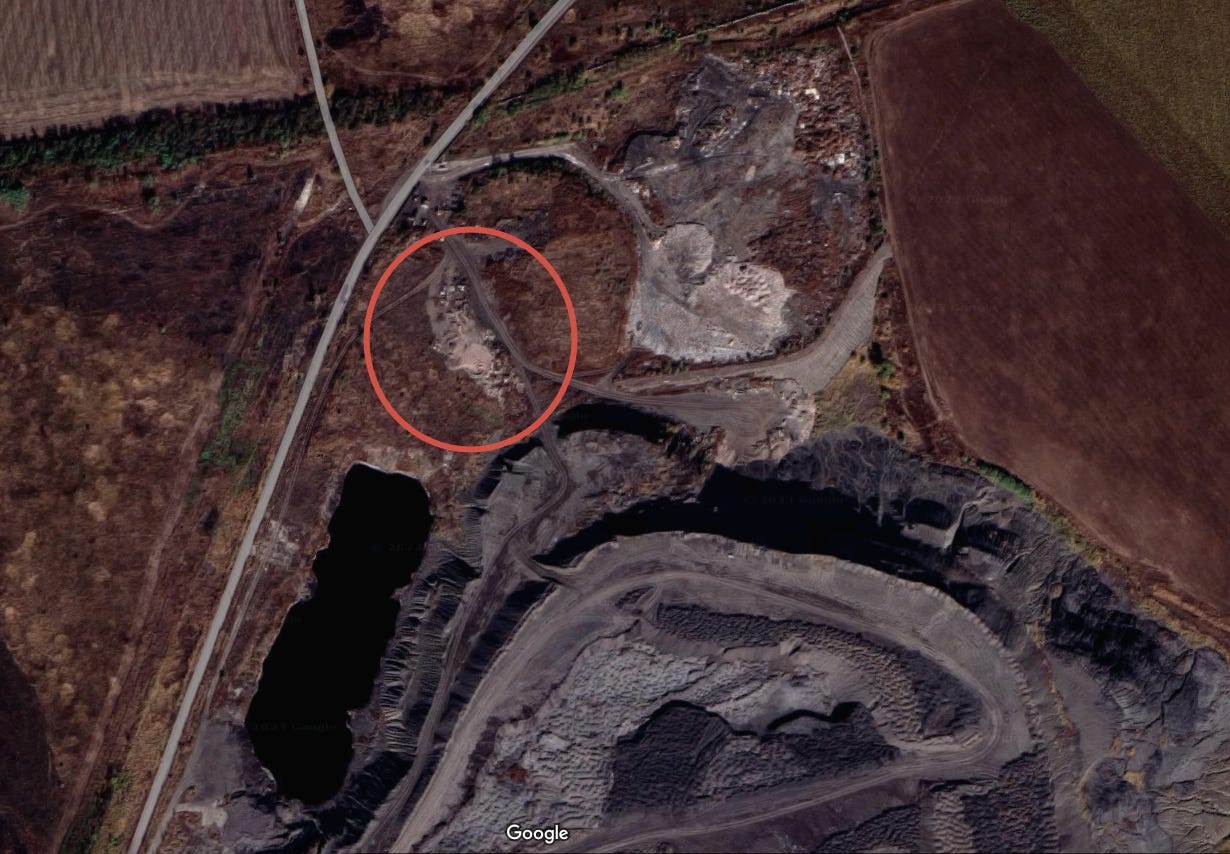
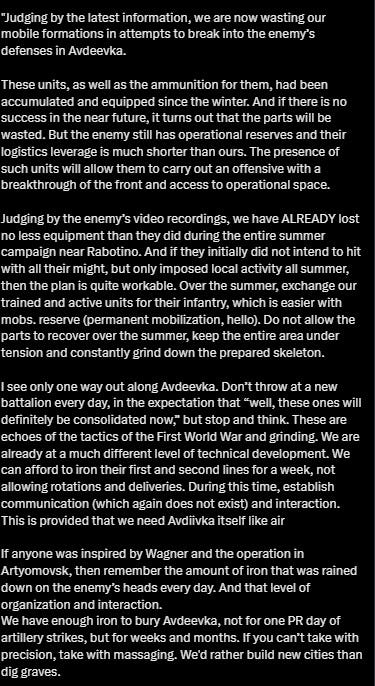
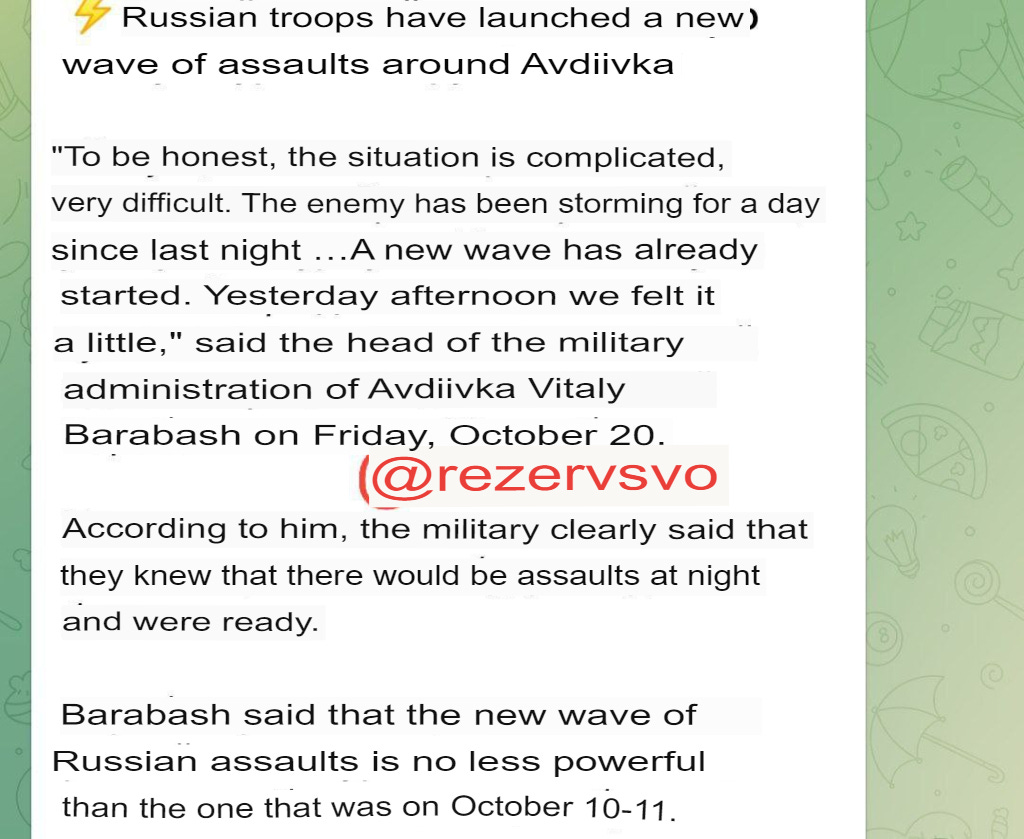

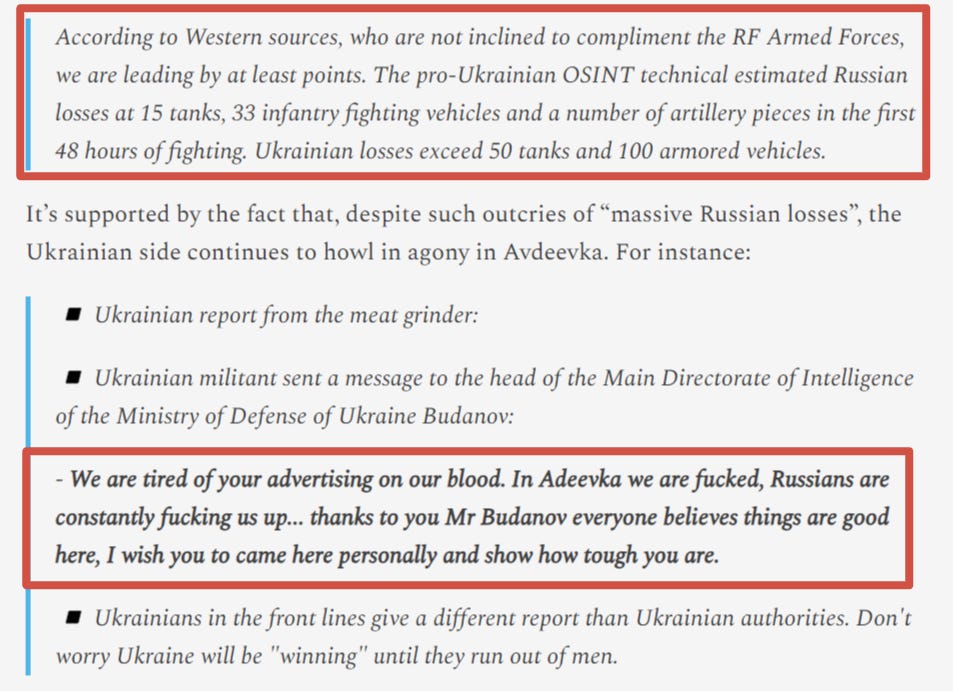

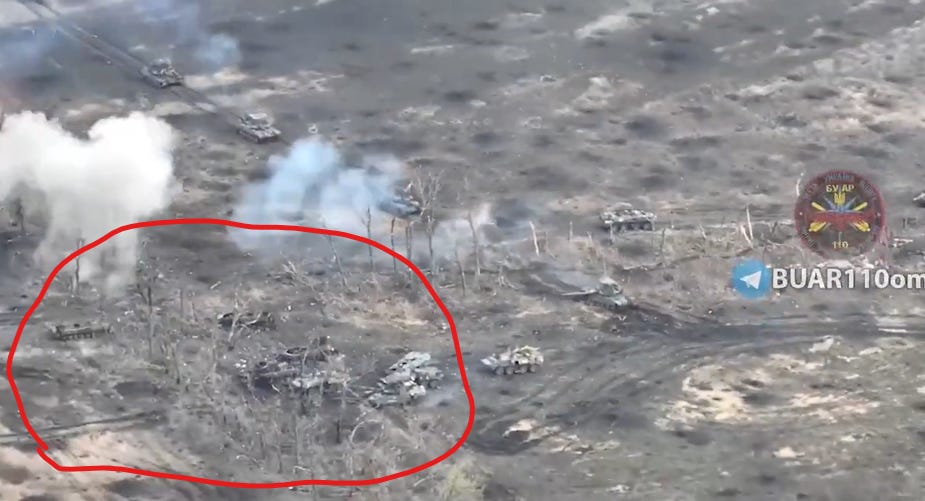
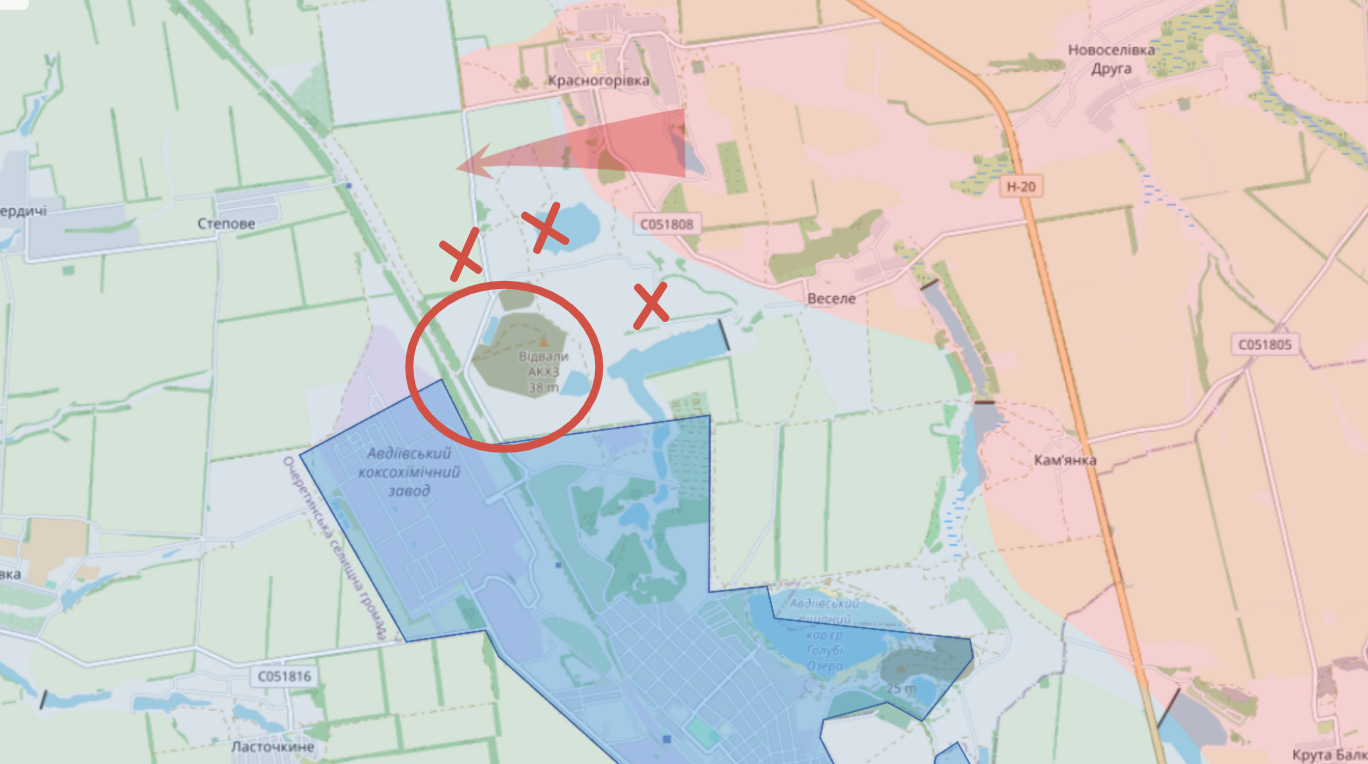
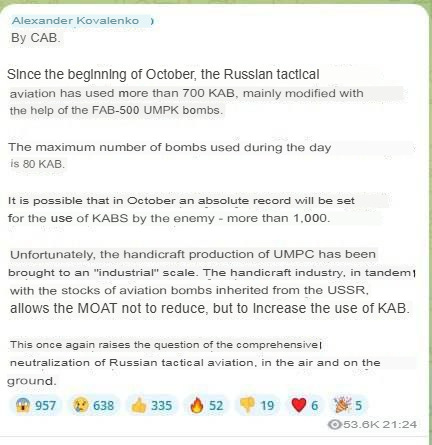
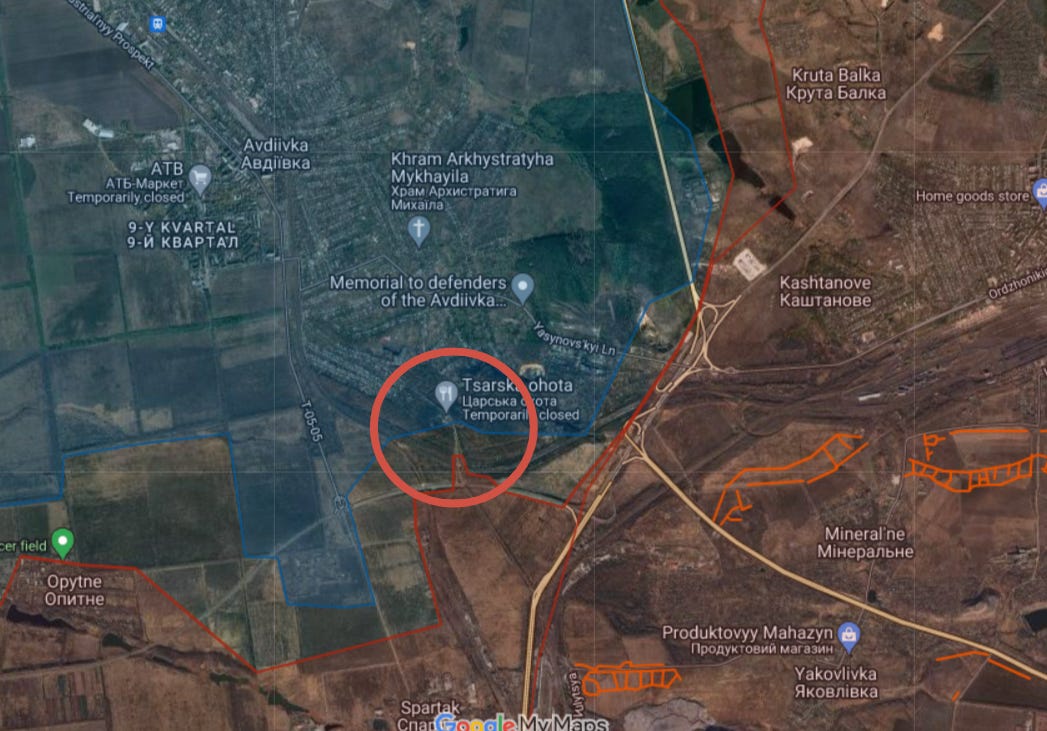
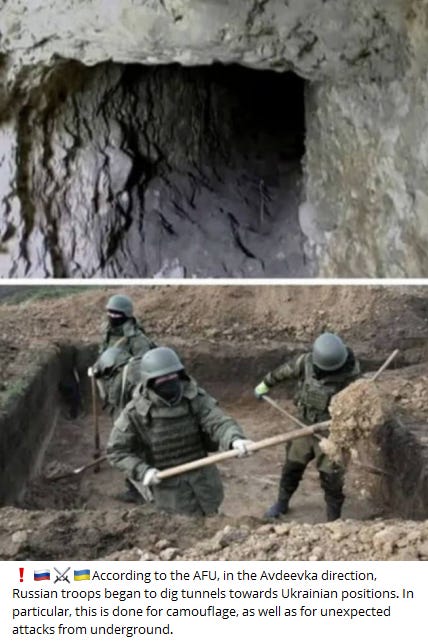
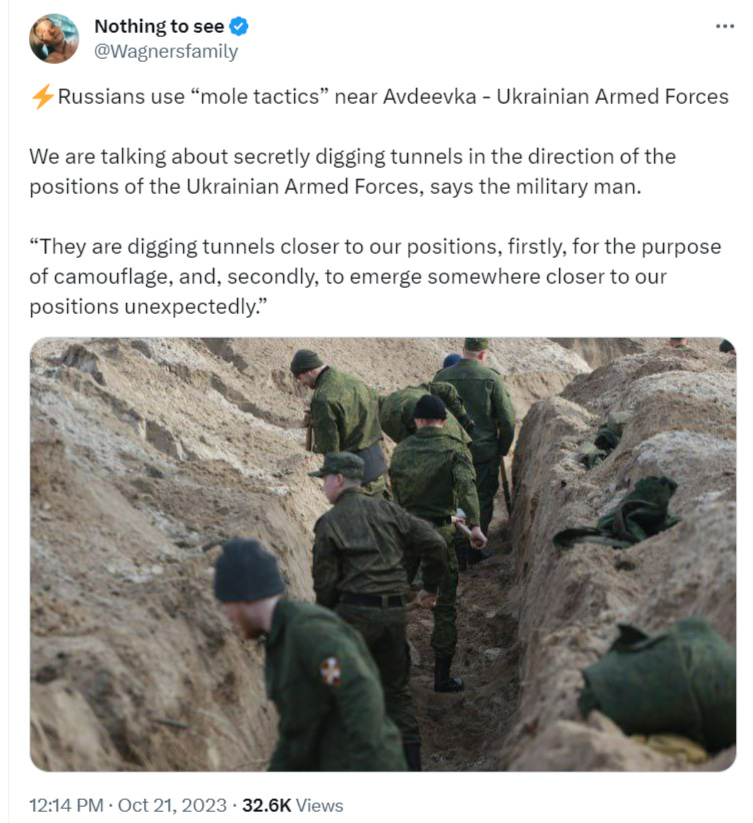
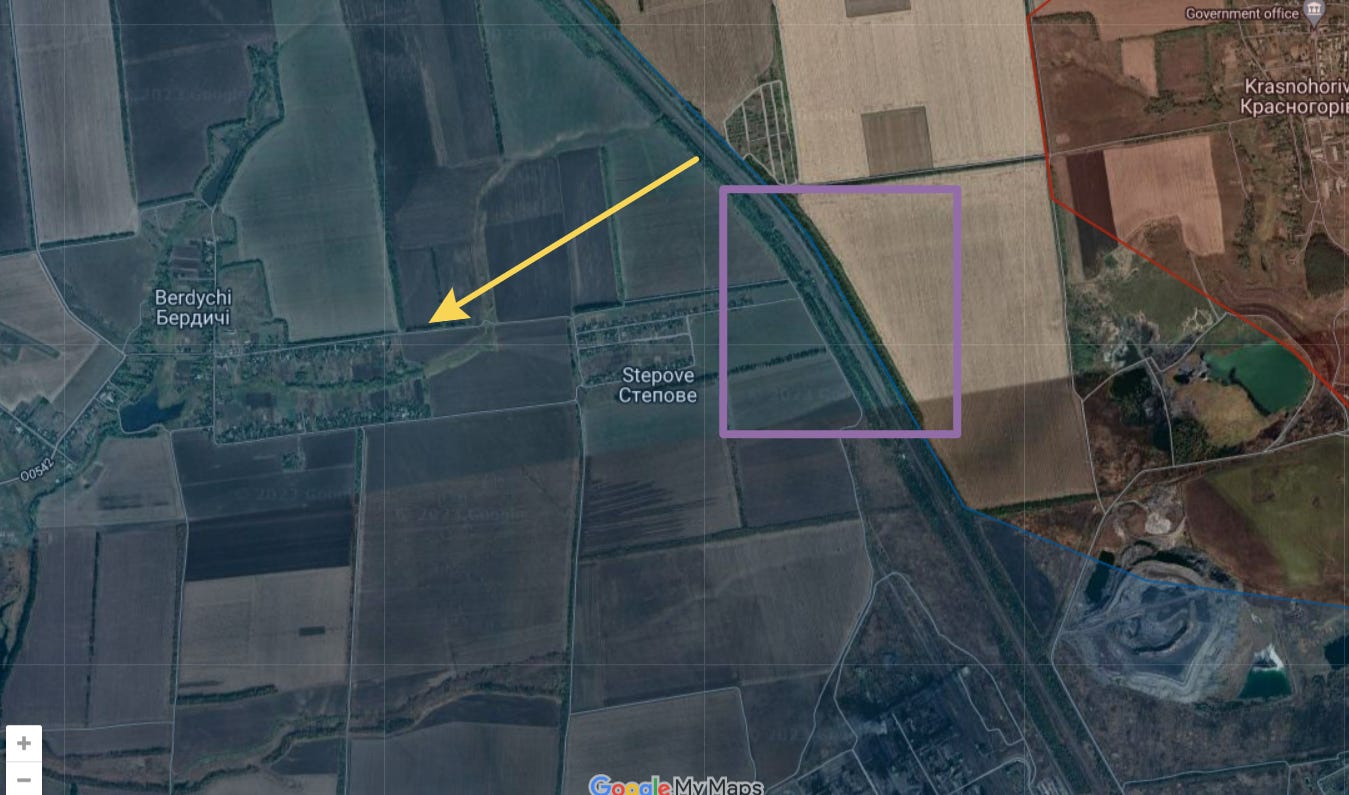
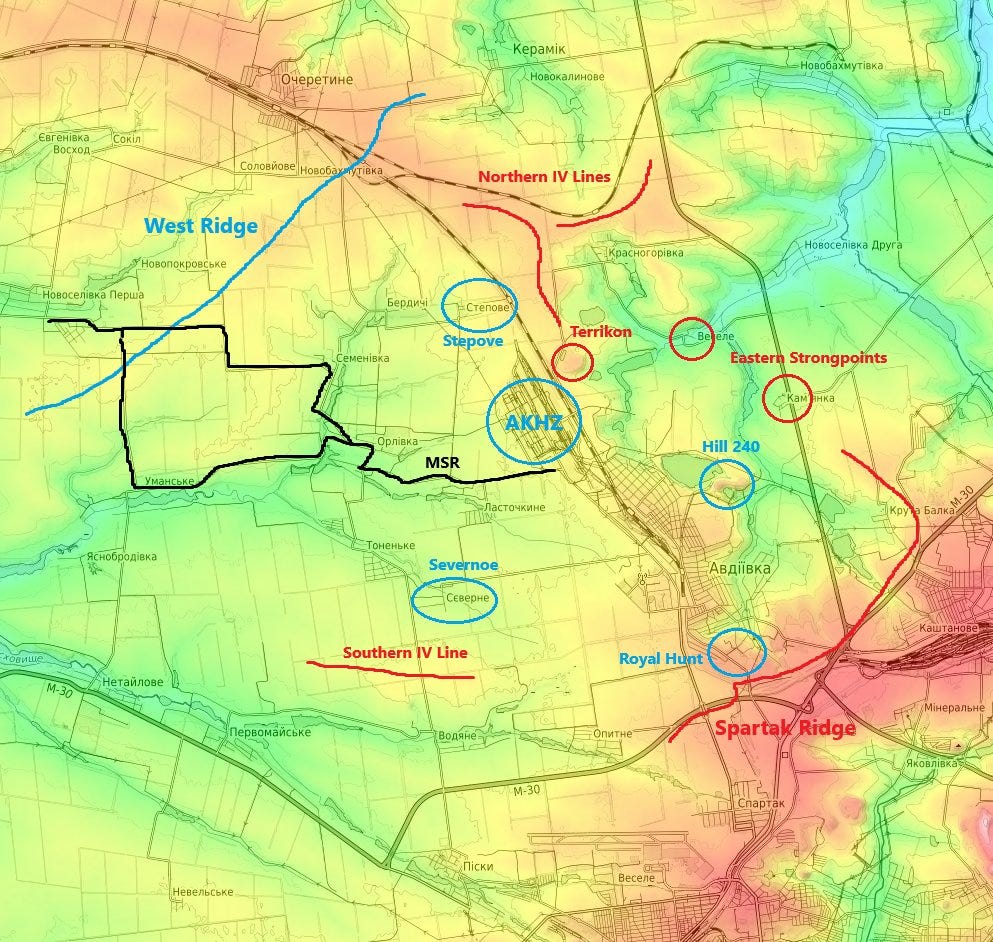
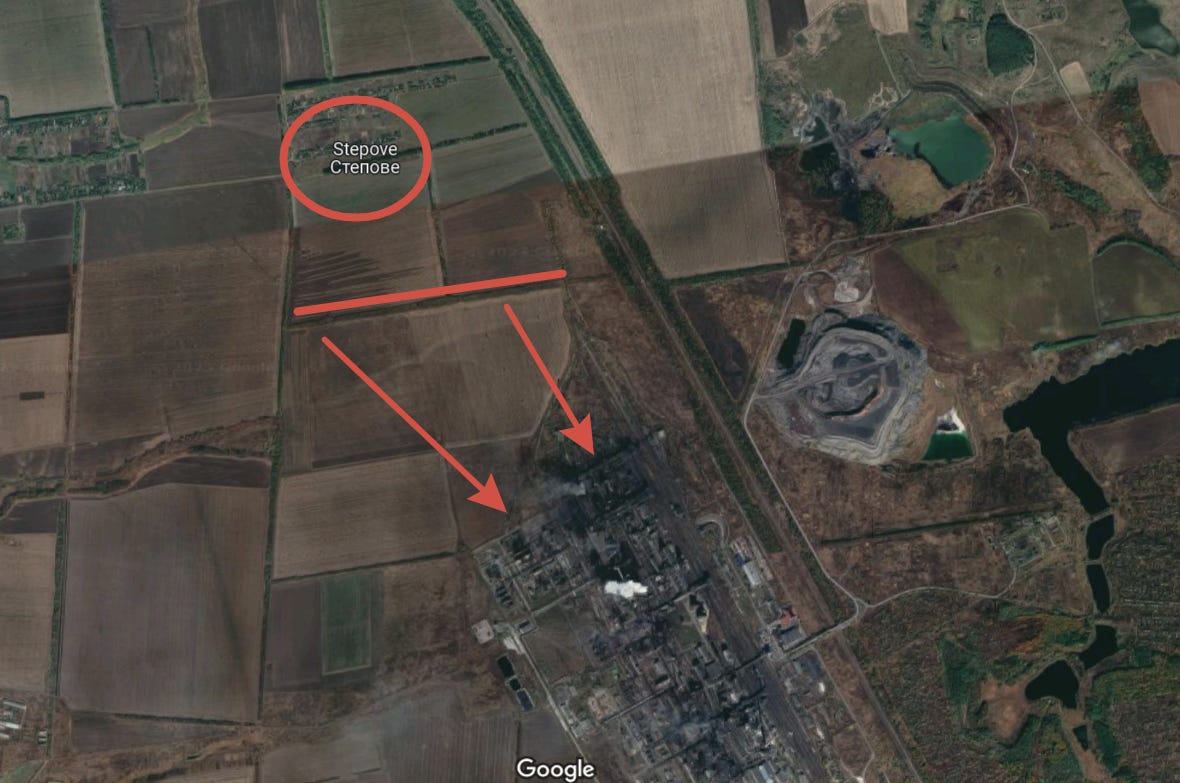
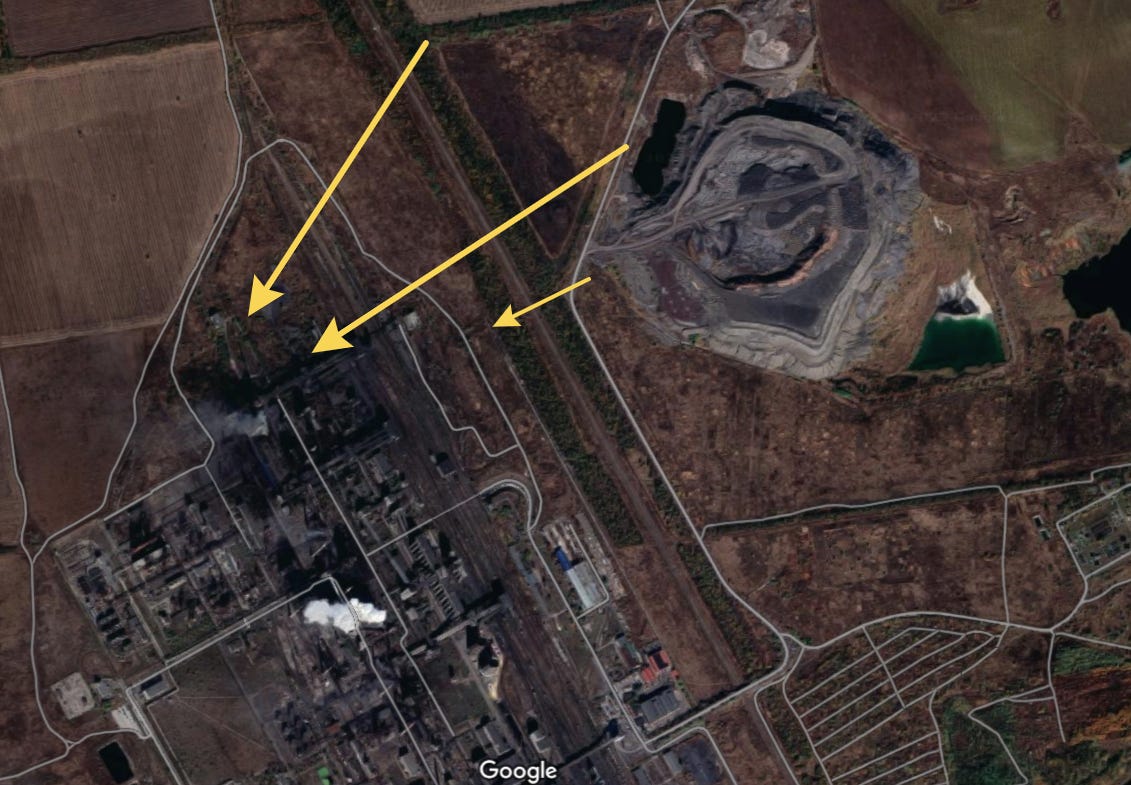
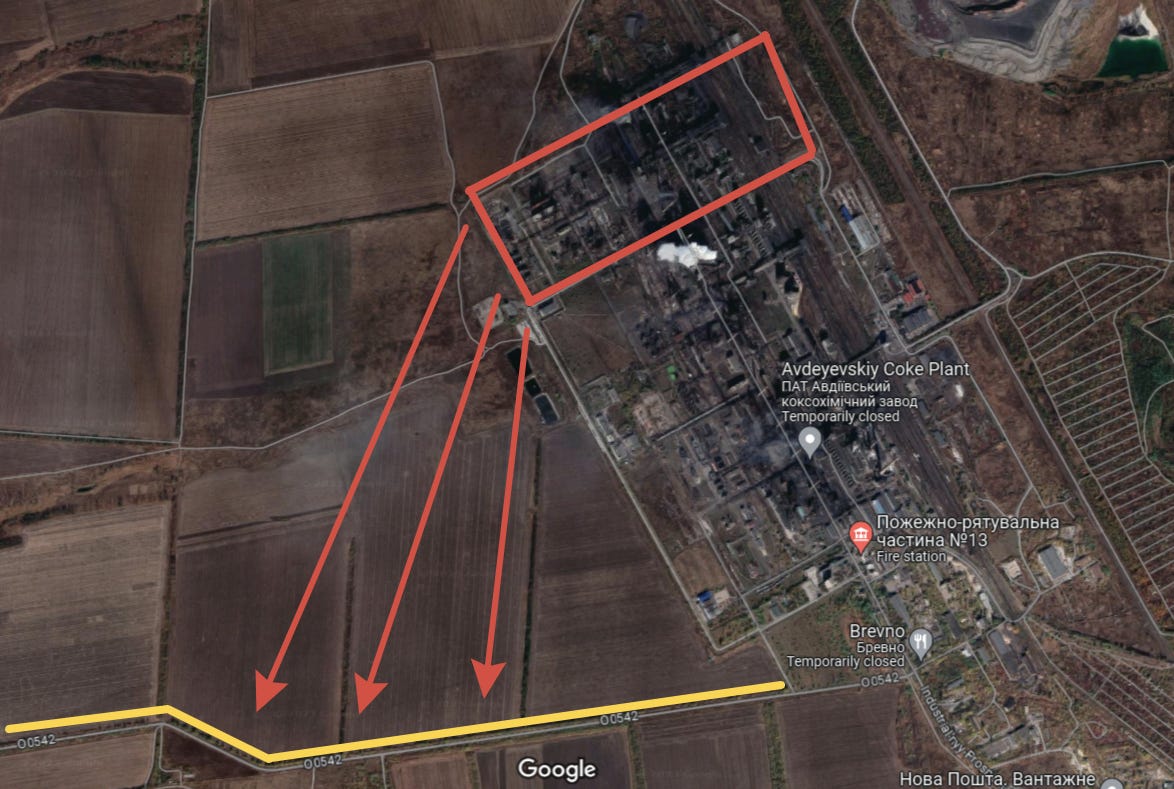
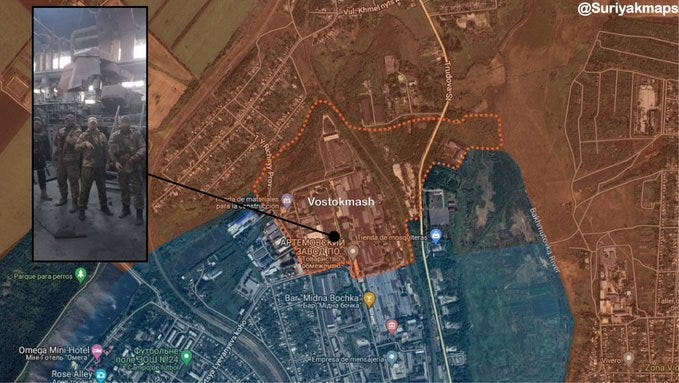

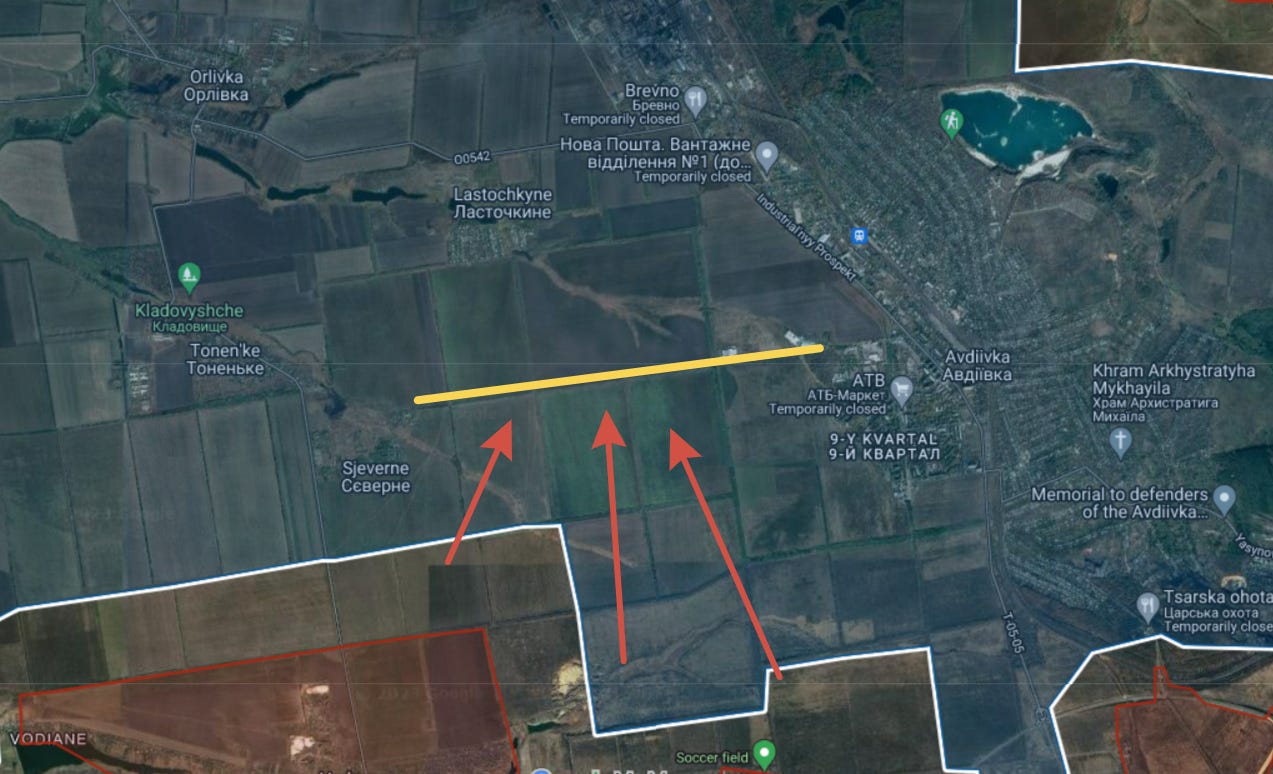
Its quite remarkable just how effective modern ATGM's are. I remember when I first heard about them was in 2006 when Hezbollah was destroying supposedly indestructible Merkavas, and then when IS started taking out Leo-2's in Turkey (although the Leo doesn't have the same "indestructible" reputation)
For a long time, the armor-myth of tanks like the Abrams and Challenger reigned supreme, to the point that tankers more or less thought themselves as impervious to harm. Yes, they could throw a track or have their optics knocked out, but nothing life threatening
Contrast that to now, where what appears to be a very small amount of ordnance - a few kg in a missile, or drone - is able to have an outsized effect on neutralizing armor. So now, modern militaries either have to come up with a way to really defend against them, or treat armor as semi-disposable.
Looking at Avdeevka, in retrospect its impressive the RuAF is attacking the way it is. I tried to imagine what NATO would do in the same scenario and I can't imagine they would even think about making an advance like this before a full year of round the clock aerial bombardment. The losses in this case are expected.
The US would just drop Agent Orange to defoliate the shrubbery. But Russia is a moral nation and won't do that. If only Putin was as evil as Biden, this war would already be over. It continues to amaze me that the Ukrainians don't realize they are fighting a US Proxy war to the last drop of Ukrainian blood - and the US doesn't care how many die. It's all a geopolitical game to Washington, which is now calling the war a "good investment." How ugly.